Ultimate Towing Guide
Towing a trailer is one of Australia’s favourite driving pastimes. Whether you’re experienced or an amateur, this is your ultimate in-depth and technical guide to towing heavy caravans, campers, boats and horse floats. Let’s do this dangerous task properly and safely.
Towing any kind of trailer with any kind of vehicle is inherently a dangerous task and should be treated with the respect it deserves.
The more weight you add the greater likelihood the risk will amplify and manifest themselves upon you and the general public around you. When that happens, everybody is suddenly having a very bad day.
This report is your ultimate guide to getting towing right, every single time, so that you can keep you and your family safe - as well as everyone else around you. It is a long-term resource that you can refer back to at any time.
There is no such thing as a benign transport mode, and driving a car, ute or 4-wheel drive is no different. Hitching a trailer on the back makes driving even less benign and we need to understand nature of the beast. So let’s do that first.
CONTENTS
Looking for specific information about towing? Click on these links below to skip ahead.
Choosing the right tow vehicle >>
Towing off-road: consider a truck >>
If you’re planning to tow a trailer off-road, check out the AutoExpert Ultimate Off-road Guide here >>
TRAILERS & TOWING
Heavy trailers - pig trailers, with centralised axle groups - like caravans, boats, horse floats, etc., are essentially unstable in yaw and pitch. This is not a drastic problem on light trailers, but it certainly can be on the heavy ones.
We’ll discuss shortly and in detail why yaw and pitch are so important to understand when towing. But essentially, it doesn’t take much for trailer sway to take control of directional stability. Dashcam footage provides a great learning tool and there’s plenty of it these days.
Basically, it goes like this: you’re towing a decent-sized boat (for example), and you decide to overtake two cars, the boat -trailer combination starts to wriggle, horizontal movement follows, without knowing what’s going on behind you, the entire trailer, your vehicle and your family in the back ends up on your side, and there’s glass and McDonald’s and hair flying everywhere as the vehicle grinds to a halt on some regional road in the middle of nowhere as you try to figure out if everyone’s okay and how to get out of the vehicle resting on its doors. Oh, and the boat is now in front of your vehicle somehow.
This isn’t some fantasy. It happens all the time on Australian roads - we just never hear about it. And this specific example did happen, for real: (See right)
‘Pig trailer’ design relies on the underlying stability of the towing vehicle towing it to keep things under control in those rotational planes of pitch and yaw. So, the bigger the trailer, relative to the vehicle, the easier it is to lose control, which is why towing 3.5 tonnes with a ute is so insane - despite the manufacturers encouraging it, and the regulators allowing it.
And, towing a big, heavy trailer at 100km/h is also insane. Even with a LandCruiser or a Patrol.
It’s increasingly less rare to catch this kind of event on video these days as dashcam footage proliferates, but rather than have a laugh, this as an opportunity to stop this kind of thing happening to you, or around you, as you drive down the highway.
Now that we’ve acknowledged these kinds of towing disasters are real, and potentially deadly, let’s get into the details about why it happens, and then stop it happening to you.
WHY TOWING IS INHERENTLY DANGEROUS
Semi-trailers (ie trucks) are optimised for the carriage of the trailer, whereas a ute is optimized for the carriage of people and stuff in the tray. Then, from time to time, it can also tow a trailer.
When you look at them with your rational filter on, they're completely different vehicles. This is why you should avoid the mindset of pretending your ute is some kind of Tonka truck. It’s not.
Utes and 4WD wagons are designed for periodic towing or moderate towing - because they're passenger vehicles, they're light vehicles. Utes are the Jacks of all trades.
Whereas a semi-trailer has one primary function, which is to pick up an enormous, full trailer and take it a really long way. If you're in the semi-trailering/trucking business, you only get paid for delivering the payload. That's why it's called a ‘pay load’, because that's the bit you get paid for. It's very important to optimise those vehicles to carry the maximum amount of cargo.
So their fundamental design needs to be fit-for-purpose.
Your typical caravan has 90 per cent of its load on the centralised axle group, and it's got 10 per cent of the load on the tow bar.
Whereas semi-trailer has 60 per cent of its load on the three rear axles (spread across 12 tyres), and the other 40 per cent is borne up the front by the rear end of the prime mover which is essentially two great big steel axles (connected to the engine, supported by 8 big load-carrying tyres) with huge sets of springs on each of two axles for a completely different load-carrying design.
Your ute (or LandCruiser) could not be more fundamentally different in its design purpose.
Let’s not forget that the ‘towball’ connection for the truck and semi-trailer is directly on the top of the prime mover’s bogey sets. It’s specifically above the two load-carrying axles at the rear end of the truck.
Whereas the towball on your 4X4 wanking chariot is at least a meter behind the back axle, allowing for some very undesirable rotational torque multiplication events if things go horribly out of control. Or simply if you aren’t paying attention.
.
APPLIED PHYSICS of TOWING
Stability
Stability sounds like a pretty boring term, but it’s the most important aspect of towing. Towing should be an event-free task - you don’t want anything exciting happening while you’re towing. The way you achieve this is through mitigation; reducing risk and avoiding disaster. But you have to do this constantly.
Some of the first intentions of a ute owner is to modify it to ‘cope’ with heavier loads, so let’s dispose of the non-issues first, starting with height, suspension and upgrades.
Obviously these things do play into stability, but they’re not primarily related.
If the suspension is not deficient, don’t go ‘fixing’ a ‘problem’ which doesn’t exist. Don’t go modifying your suspension, because you probably don’t need to.
Height of the vehicle is not really relevant to stability, unless you change it (with some kind of lift kit or modification) to be higher than normal, which will make its stability worse. Again, don’t change it; it’s probably unsafe and pointless, and makes the vehicle worse.
Let’s look at the primary factors that relate to stability when towing.
1. Grip
Essentially the vehicle is not a free body, because it’s anchored by four contact points at the tyres.
Tyres are a big deal - especially pressures, their condition, and their maintenance. Also, the kind of tyre you use matters.
Many people put knobbly off-road tyres on their vehicles, their caravans and campers, which is only going to make it less stable on freeways and back roads because the chunkier the tread pattern, the less rubber is connecting with the road in the majority of driving. Prioritise the tyre performance for the 90 per cent of the driving you’re doing, where the trailer needs utmost stability - on public roads. All-Terrain tyres are the best option here for all-round grip with sealed roads and dirt roads. You cannot improve stability and performance on the highway (90 per cent of your driving at 80-110km/h) and the bush (at low speeds).
Also, don’t tow 3.5 tonnes off-road. And on dirt roads - slow down. It’s very simple; reduce the amount of energy you impose on the vehicle and trailer, by just going slower.
2. Wheelbase
The vehicle’s track often gets included when talking about wheelbase, but they’re both kind of irrelevant. Track has an influence, but virtually all vehicles are pretty identical; they’re all kinda the same when it comes to track.
Wheelbase also has an impact, but all the utes and 4WD wagons are quite similar, in relation to their effect on towing stability.
Nobody will argue a 300 Series LandCruiser is a lesser towing vehicle because it has a shorter wheelbase than a Ranger, and nor is Ranger a poorer tow vehicle because it has the longest wheelbase of D-Max/BT, Triton, Hilux or LC.
Length, between all of these vehicles, is very close, so it’s also pretty irrelevant. The most realistic exception here is when there is an outlier vehicle that is in an emergency situation, such as suddenly swerving at high speed when heavily laden. The wheelbase and track do play a role here, but you should already see that they’re not the primary causal influence here…
The biggest determinant of stability is their overall kerb weight.
3. Relative size & mass
It’s important to have a much heavier prime mover relative to a trailer, when it comes to utes and towing. You have greater stability when that relativity is greatest.
Of course, trucks don’t work like that, because they’re designed completely differently, with groups of axles right at the ends, and wheels right at the corners, there’s maximum possible weight over the driving wheels of the prime mover and the whole combination is designed specifically to carry extremely heavy loads - whilst remaining stable.
Utes and caravans are not designed like trucks, B-doubles, dog trailers et al. Towing is a complete afterthought when designing a ute. The ute’s primary purpose is to haul light loads, very well. That is its mission, like the T-800 in Terminator 2: Judgement Day.
Overwhelmingly, the LC300 is the best tow package with the most grunt and the most kerb weight, so it is therefore the most stable tow vehicle. But it is also overwhelmingly the most expensive. And it doesn’t change the overall nature of the pig trailers it tows with their unstable design.
Utes and 3.5-tonne trailers are a match made in engineering hell, because it’s entirely impractical and manifestly unsafe. Most ute manufacturers and their ads will tell you 3.5 tonnes is possible - they celebrate and advertise it, even. But in practise, you can’t, and the numbers don’t lie.
Mounting that $100k 3.5 tonne trailer onto the 50mm towball of a D-Max is a very different towing assignment than putting it on the back of an Isuzu NPR - a real truck.
But that 3.5 tonnes - you’ll be doing it illegally in any of the common utes. You can only hypothetically tow 3.5 tonnes - and if you do, you can’t carry the family, or even a cut lunch. And the manufacturers of these vehicles should hang their heads in shame for collectively suggesting not only you can do this, but that doing so is an excellent idea. Because that’s grossly irresponsible.
The best way to mitigate this disaster-waiting-to-happen, is to minimise the mass disparity on the trailer. This doesn’t really apply to short trips like to a local boat ramp, because you’re probably not going to reach high speeds.
But at highway speeds of 80km/h, 100km/h or 110km/h, you have acquired a huge amount of kinetic energy. When that energy is dispersed or transformed in a short period of time, that’s bad. Just look at crash testing: big energy, transferred in a short time frame.
4. Load distribution
What really matters next, when towing with a ute in particular, is load distribution.
You have lots of different masses, when loading your ute and trailer, and it’s highly important where you locate them.
It’s more important to put heavy stuff between the rear wheels in the ute, fore of the rear wheels, which is often hard to do in utes. This is due to the design of utes where often the rear wheels are underneath the rear of the cabin (or very close to it), meaning they’re often at the front of the loadspace, not in the centre; they abut the cabin.
Where you put the load in the back matters, and often it creates a laziness with ute owners who can’t be bothered putting the heaviest items at the front of the tray.
How you load your vehicle is pivotal to stability. Now, if you go and add a trailer to this situation, the instability of your ute becomes amplified when you’re towing - especially in the event of some sudden and high-input event like an emergency swerve or hard braking. The trailer can quickly and easily overwhelm the ute’s margin to remaining under control.
5. Rotation
Linear movement is relatively simple: An object has force applied upon it, so it accelerates forward, which is called displacement. Linear movement is up/down, left/right, forwards/backwards.
As soon as you start learning about angular movement, things start to get complicated, especially when it comes to towing.
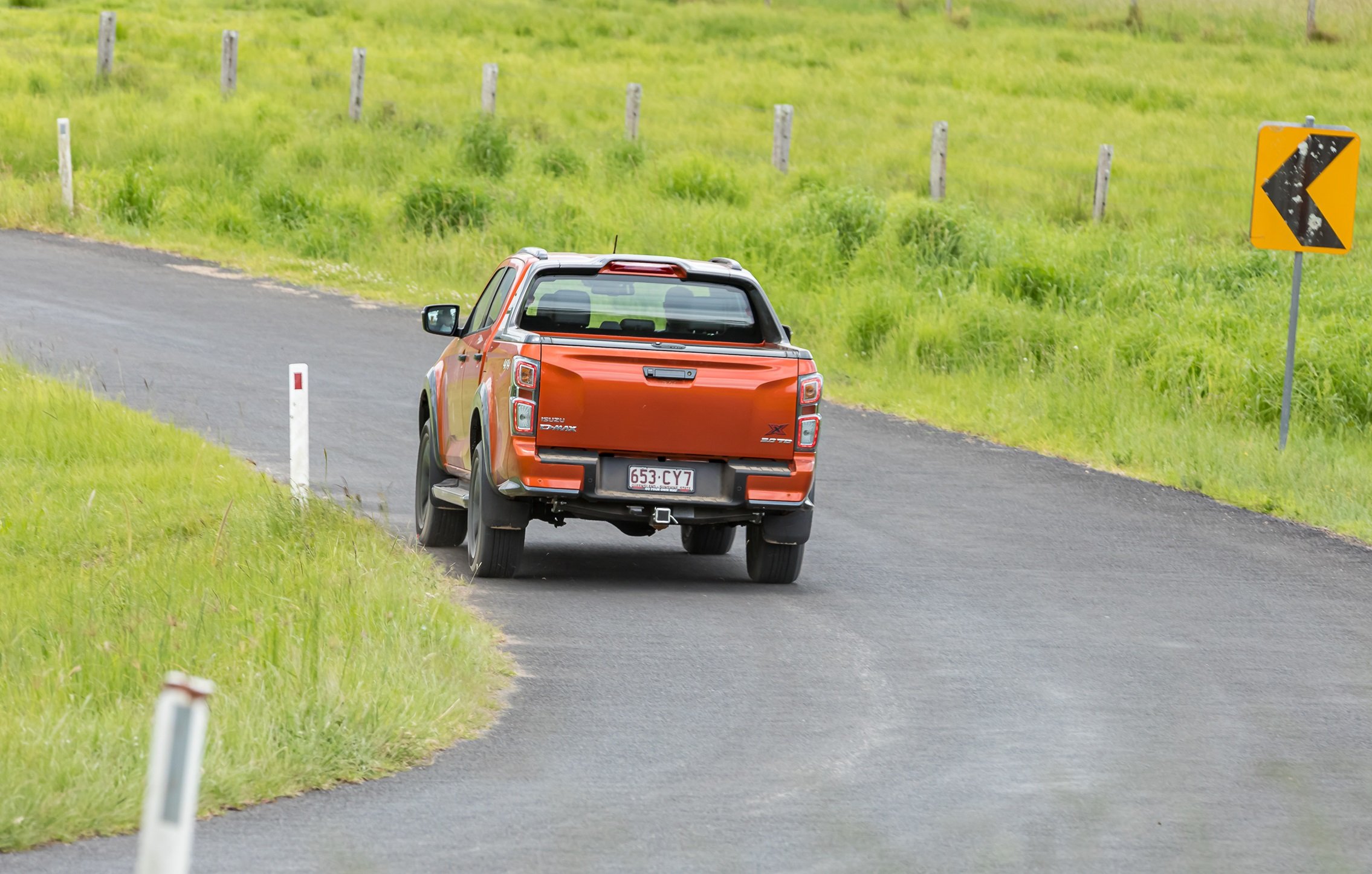

It’s all about Newton’s second law, which is arguably the hardest to learn and understand. It basically says that the amount of force applied to an object will have a proportional response on a mass, depending on its weight, and depending on the amount of force applied.
The rate of acceleration your vehicle will have will be proportional to how heavy your vehicle is and how hard it gets hit by the vehicle behind (how much force it applies).
When it comes to rotation, or angular movement, shape and size matters.
Your ute has a geometric centre of mass roughly in the centre of the four wheels, and the rotational inertia applies here. If you add weight to the object (the ute) you dramatically change the stability and how it will react out on the road. When your heavily laden ute rotates, or turns, or swerves, it’s much, much harder to slow down or control that movement compared to when it’s empty.
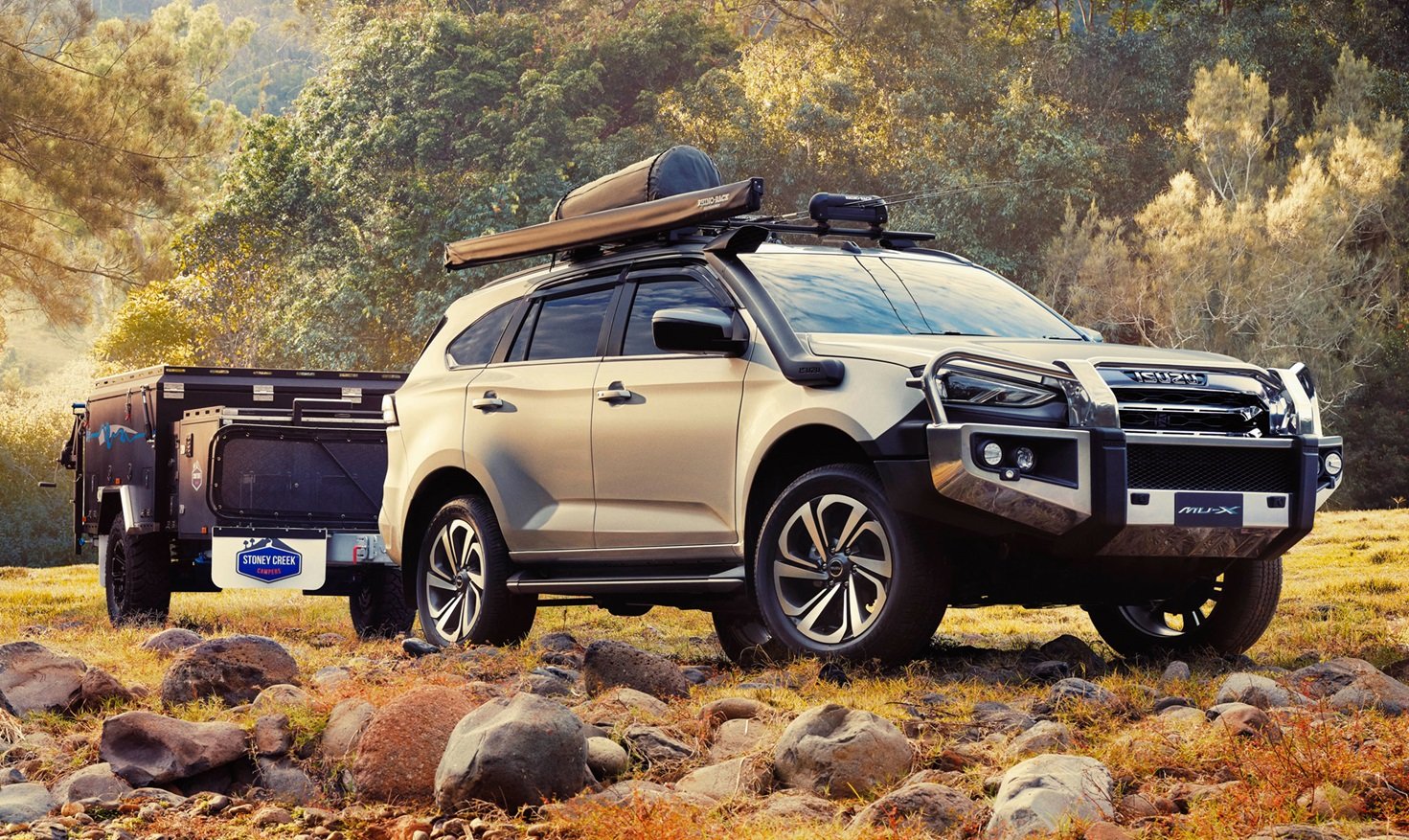
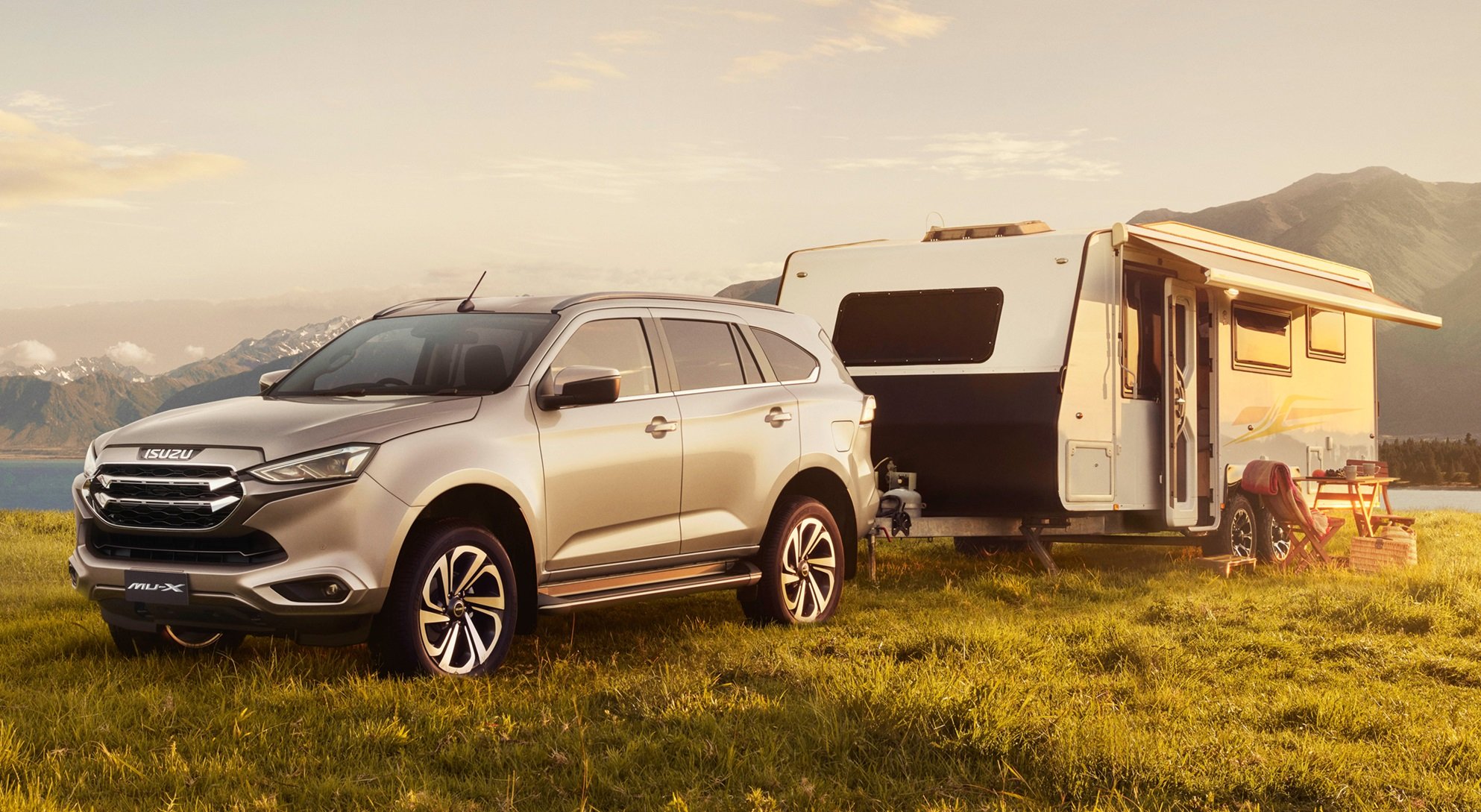
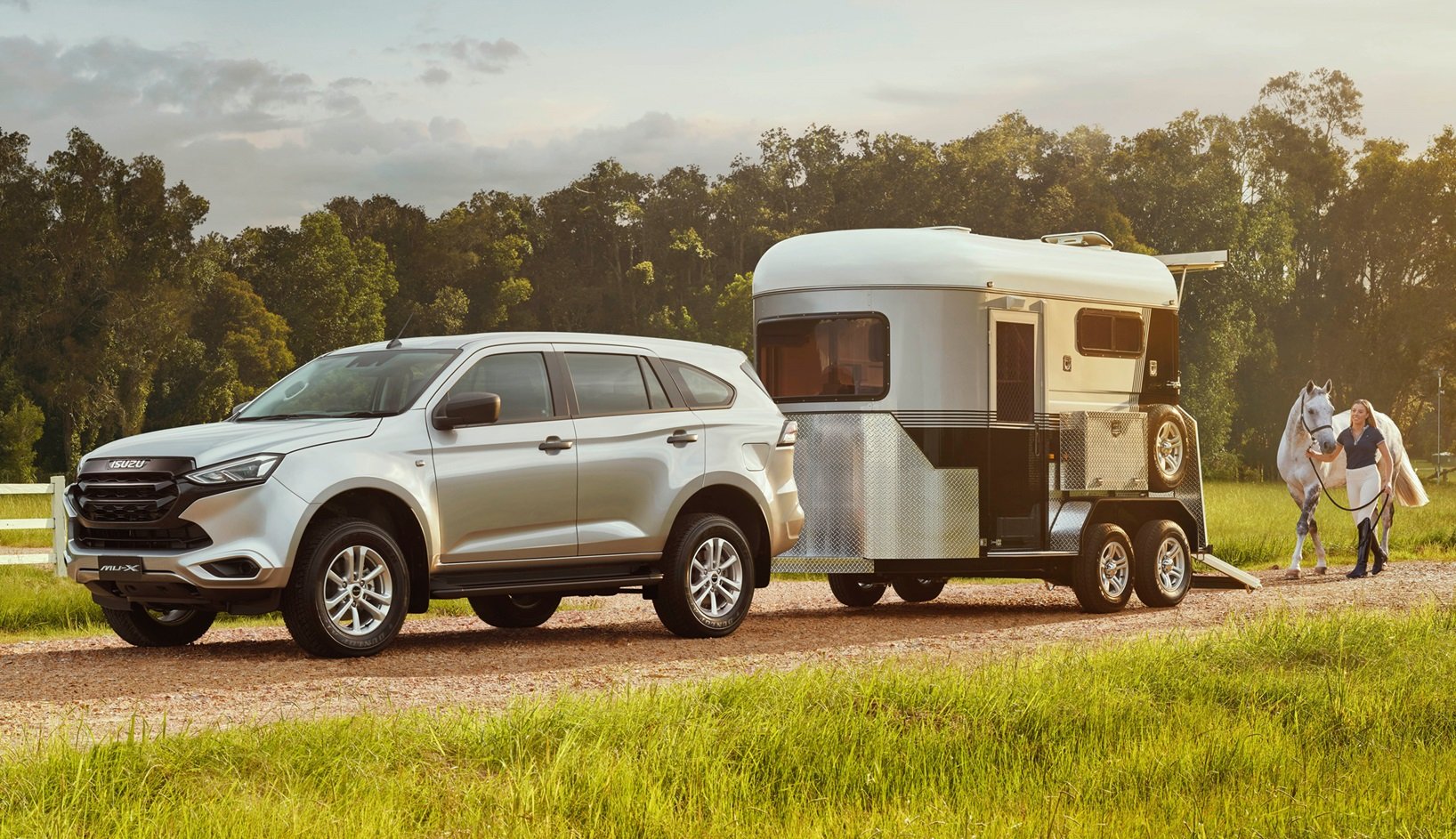
And your trailer, depending on its size and shape, has the ability to apply force on your ute and influence its stability, which we’ll refer to as ‘disruption’.
Disruption 1: Pitch
Your trailer has the potential to disrupt your vehicle. The fundamental truth is that the biggest influence in stability with trailers and caravans is weight, size and shape.
A 1500kg pop-top camper is not trivial, but has a very different capability of influencing your vehicle than a long, tall, 3.5-tonne caravan. It’s much easier for your tow vehicle to control the disruption of a small 1500kg pop-top than a 3.5-tonne caravan combination.
The most extreme example of this, to illustrate the point, is horse floats. They are very tall, with a dynamic load on board that is itself a large mass quite high off the ground, making it predisposed to sway and pitch.
Pitch is basically a see-saw and that’s the one of two primary directions of movement of any trailer/caravan.
The centre of mass is about 10 percent forward of the axles, and pushes down on the vehicle, which is good because you need the tow vehicle’s rear axles loaded so the caravan follows around corners.
Every time you hit a bump, the trailer/caravan pitches, the axles unload somewhat, and the mass-centre pushes up very briefly before pushing back down again in the see-saw motion.
When this happens, as the trailer pushes down on the tow vehicle’s towbar and rear axles, it lifts the front end, making the steering lighter because there’s less weight pushing down on the wheels to grip the tyres and the road.
Again, the heavier the trailer, the more significantall of these these effects will be on the road in terms of stability. The bigger and heavier the object, the less stable the caravan and tow vehicle are.
One last thing here: when you do hit a bump, the weight pushing down on the rear of the vehicle is accelerated in those directions of pitch. Up and down, the trailer accelerates up, but also down, which means for a very tiny moment, the weight borne by the vehicle’s rear axles and towbar is multiplied - because of the acceleration.
So the towball download you exert on the vehicle, might be 200-300kg when stationary (what we call a static load), but when you’re doing 80-100km/h or something, when you hit a pothole or bump, or when you swerve, that dynamic load accelerates downward or upward on the vehicle. Or worse - it accelerates left or right…
Disruption 2: Yaw
Yaw is the second primary influence of a caravan and the tow vehicle, like your ute.
Yaw (too much yaw) is effectively what happened here:


Every time you drive around a corner, towing your caravan, the trailer has to yaw. At the end of a corner, the vehicle has to tell the caravan/trailer to track straight, which means stopping it from rotating in yaw. Otherwise it will want to keep rotating.
Unfortunately, both pitch and yaw disruptions can happen at the same time. It’s as simple as hitting a bump mid-corner on an off-camber corner.
The trailer rotates in yaw because of the bend, it pitches because of the bump, and if the weight is great enough, it will overwhelm the tow vehicle’s ability to resist the influence of the disruptions caused by the trailer. There’s only so much compensation you, as the driver, can execute in this moment.
Overhang
Too many people fixate on rear overhang, behind the rear axle, when it comes to towing assignments.
What really matters is where the vehicle is yawing around. Where is the mass centre?
It’s not about how much rear overhang there is, it’s about the distance between the mass centre and the towball (where the caravan/trailer is connected) to disrupt the tow vehicle. Essentially, the longer the distance, the longer the cantilever is and the easier it is for the trailer to influence the vehicle’s movements - disrupt.
Overhang is more applicable to the failure of the vehicle’s chassis when it comes to overloading.
Overloading a chassis
When you think about the loads imposed on a ute, you’re looking at the towball, the tray payload, people in the cabin, engine and transmission up the front, and whatever accessories you mount (like a bullbar).
In terms of responding to all these loads, you have the springs, where two attachments to the chassis front and rear (on each side) for leafs, or one front and rear on each side for coils. These springs restrain the loads.
The problem with this system is you have a rigidly-mounted cabin to the chassis, but the tray/tub is mounted also to the chassis, but it’s not bolted to the cabin - there’s a gap.
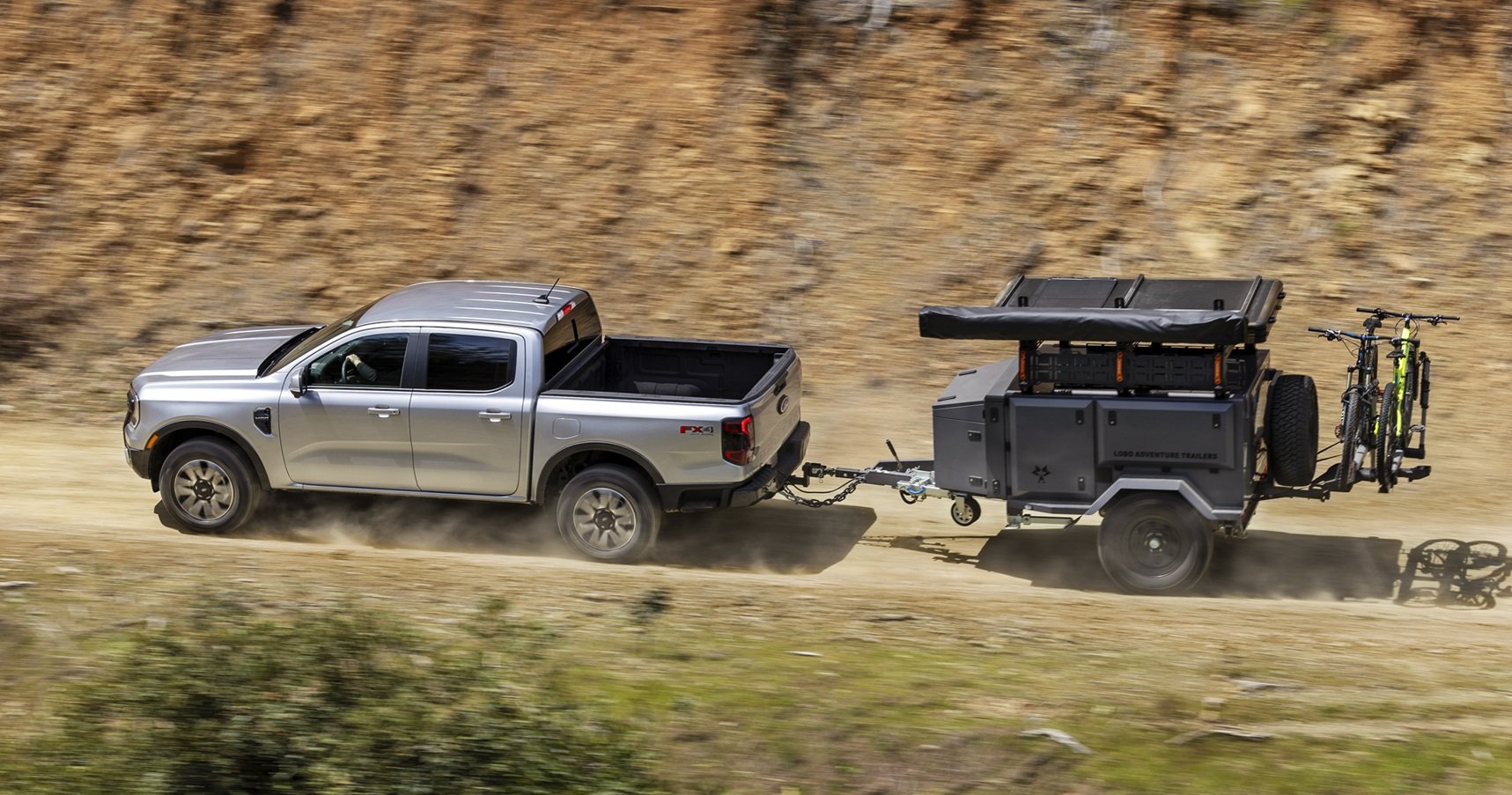
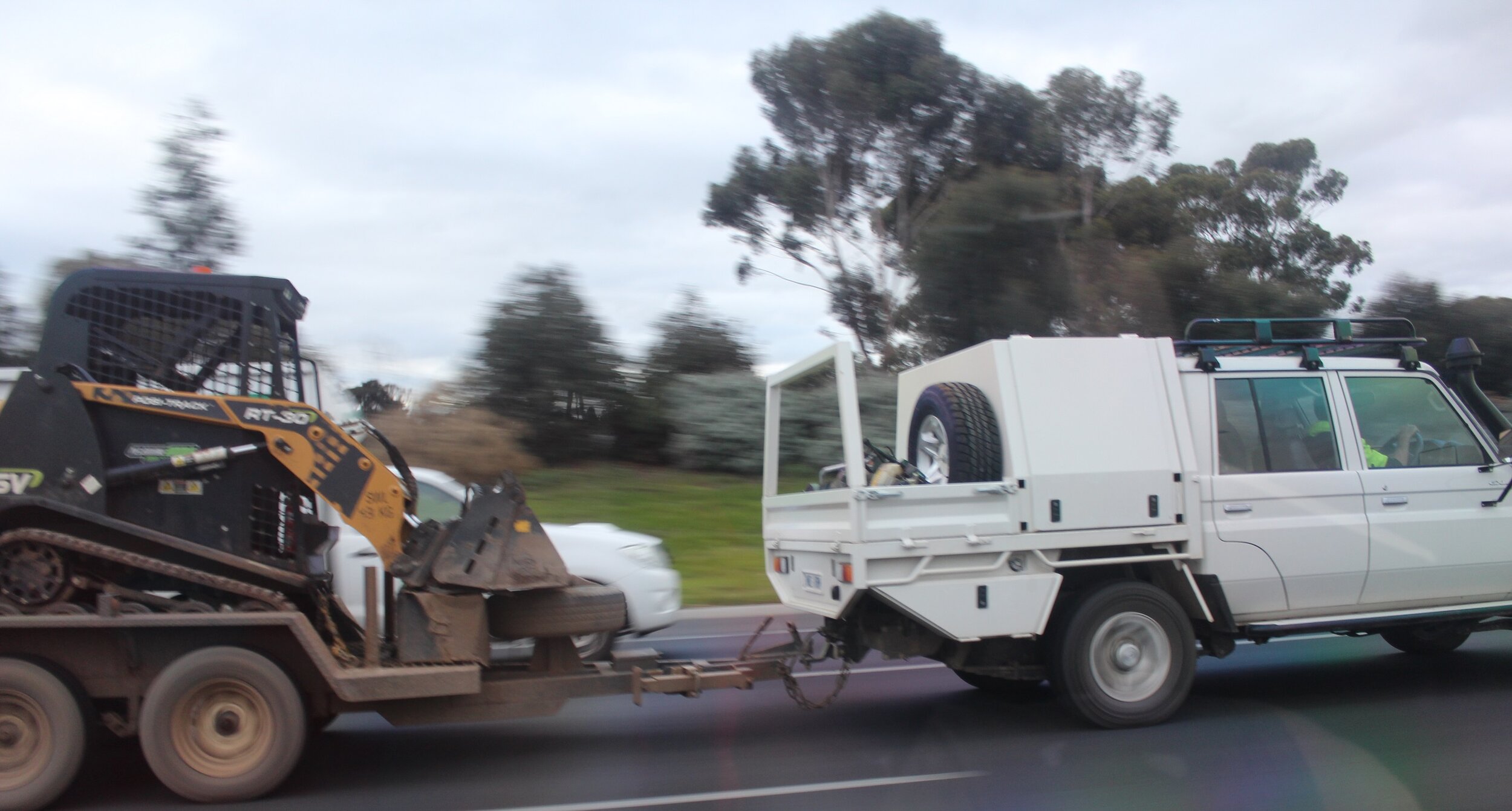
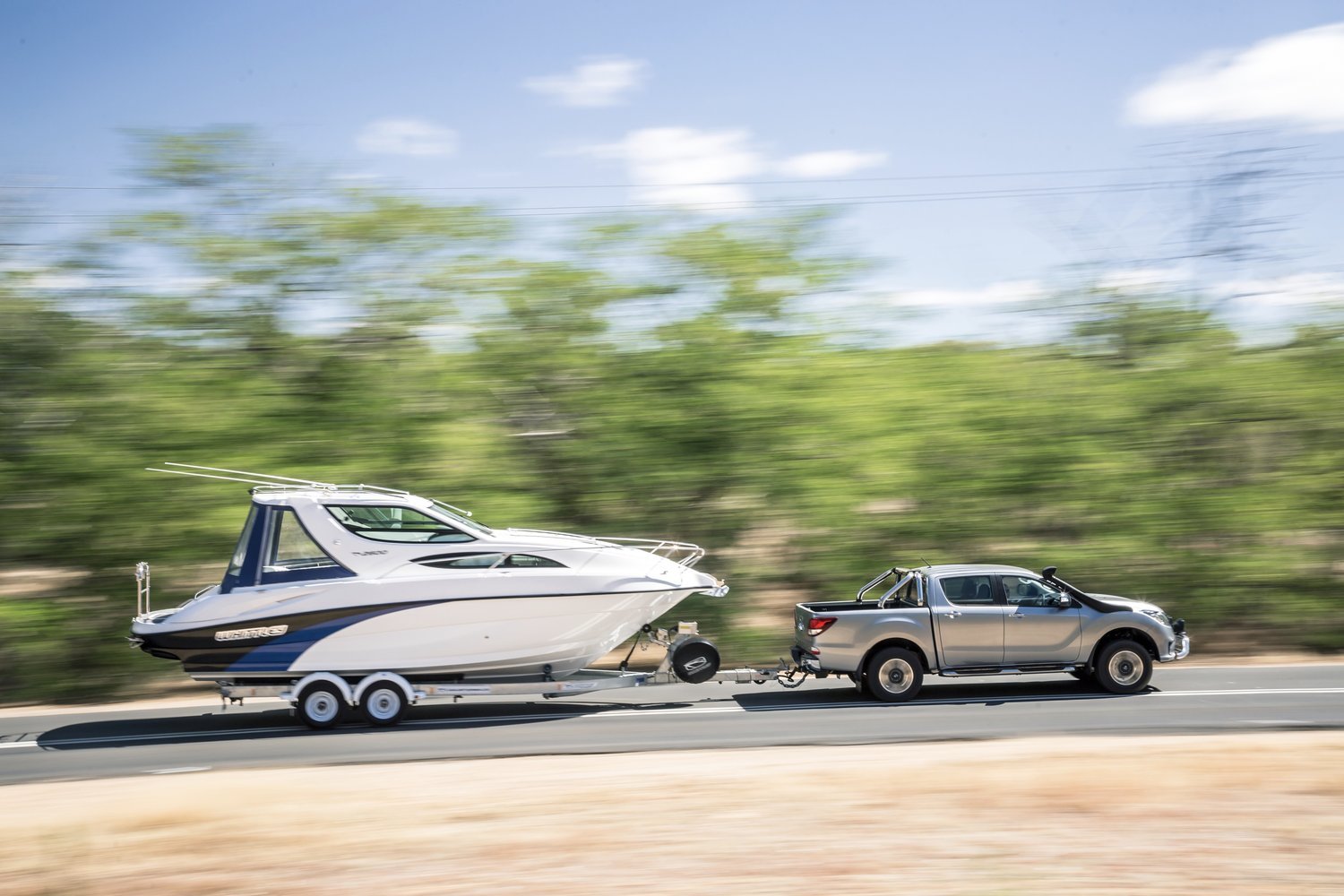
So adding heavy cargo into the tray (in addition to a heavy trailer) is the worst possible design because the chassis failure mechanism - the weakest point - is the gap between tray and cabin.
Adding 350kg of ‘static’ towball download, acting upon the chassis, turns into a recipe for a hinge on the chassis when you hit a serious bump towing 3.5 tonnes. That ‘static’ load isn’t actually static, because every bump in the road accelerates that load upward and then downward, onto the towbar/chassis.
All those loads imposed on the vehicle will accelerate (proportionally; Newton’s 2nd law) when you hit a bump, because force is acting upon that trailer/vehicle. If that acceleration is great enough, the G-force could very easily be enough to bend your chassis if it’s a 3.5 tonne caravan and the bump is sufficiently deep/high enough.
This is why I constantly advise people like you not to tow more than 2.5 tonnes, ever, with any ute (or 4WD wagon). I also encourage you to think carefully about where and how you load your vehicle and trailer.
Don’t overload the ute’s loadspace. Think about where you locate heavy payloads. Answer: centralised, over the axle.
Utes are ‘light duty’ vehicles only. Three tonnes of ute and three tonnes of trailer is right at the extreme limits of what’s operationally safe. I.E. You cannot max-out the towing and the payload it’s carrying. You must comrpomise.
.
CHOOSING THE RIGHT TOW VEHICLE
Where most people start this process entirely wrongly is by purchasing the trailer (the caravan, the camper, the horse float, the boat, the tandem car trailer - whatever) first, and then trying to find an appropriate vehicle to tow it.
Starting from this point you are completely allowing yourself to overspend and therefore over-size the trailer. Meaning, you then have to find a potentially unnecessarily enormous vehicle to tow it - or you simply take the cheapest option thinking you’re saving coin, only to find it’s not rated to tow the maximum required amount.
This means you’re stuck driving an enormous vehicle around in the ordinary traffic environments unladen, waiting for that rare golden opportune moment to hitch-up, suffering all the anxiety of harbour masters trying to park cruise liners. And you pay significantly for that, not just in the initial purchase, but ongoing costs, maintenance, fuel etc.
But there’s even more complexity to this problem, finding the right towing vehicle, below.
If you buy that prized dual-axle caravan weighing a maximum of, say 2700kg - that’s 2.7 tonnes you’re going to tow a presumably long distance - it means you have to find a vehicle with enough working load limitations to allow you some kind of practical payload.
But if you haven’t run the numbers on the vehicle before purchase, there’s a good chance you could simply hitch up the trailer, load up the vehicle and be legally overloaded as you head out on your annual pilgrimage. Especially if you chose the poverty tow vehicle.
If you're towing 2.7 tonnes, you really are living life on the edge in terms of Gross Vehicle Mass (GVM). See the ‘LIMITS’ chapter below for more on GVM.
When you look at a LandCruiser 300 GXL, you should realise just how tight the load constraints are, even at what you might presume is a reasonably conservative towing assignment of 2.7 tonnes. You might assume that's conservative, given the vehicle's notional 3.5-tonne tow limit, but here are the numbers on the GXL.
The answer is not great if you’ve already paid a deposit without doing your homework. So here goes:
The LandCruiser 300 GXL is $128,000, driveaway, in Australia. It’s about that price in every state, which is such a massive chunk of cash. It’s more than the average Australian male’s salary. Let’s look at what happens if you put a trailer on the back.
Assume it's 2.7 tonnes of total weight to be towed, with a towball download limit of 270kg, this is a vehicle with a kerb weight of 2.58 tonnes. It weighs more than 2.5 tonnes. It's got a GVM of 3280kg. So the available payload in total, is 700kgs. Towball download is included in the payload because the vehicle is carrying it.
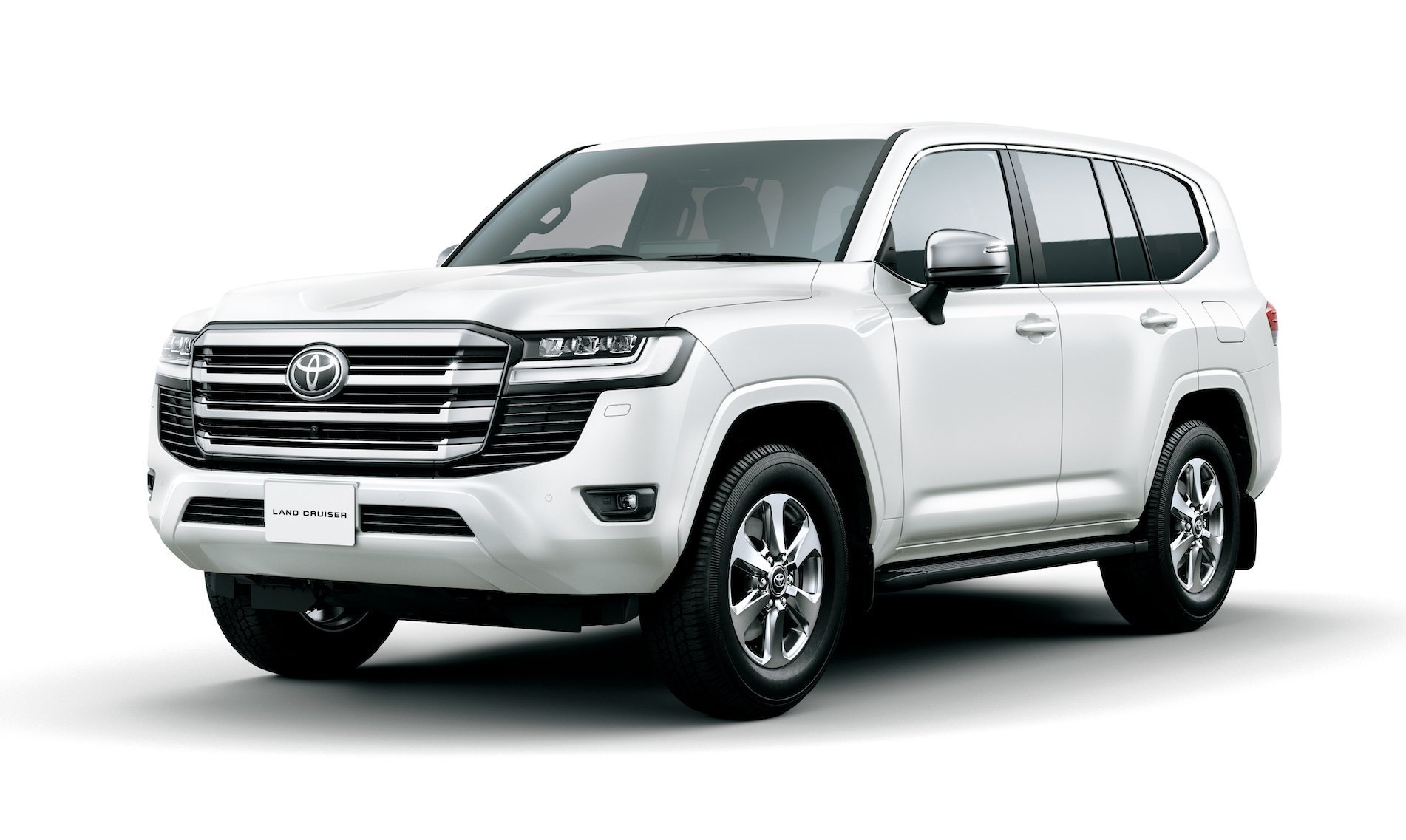
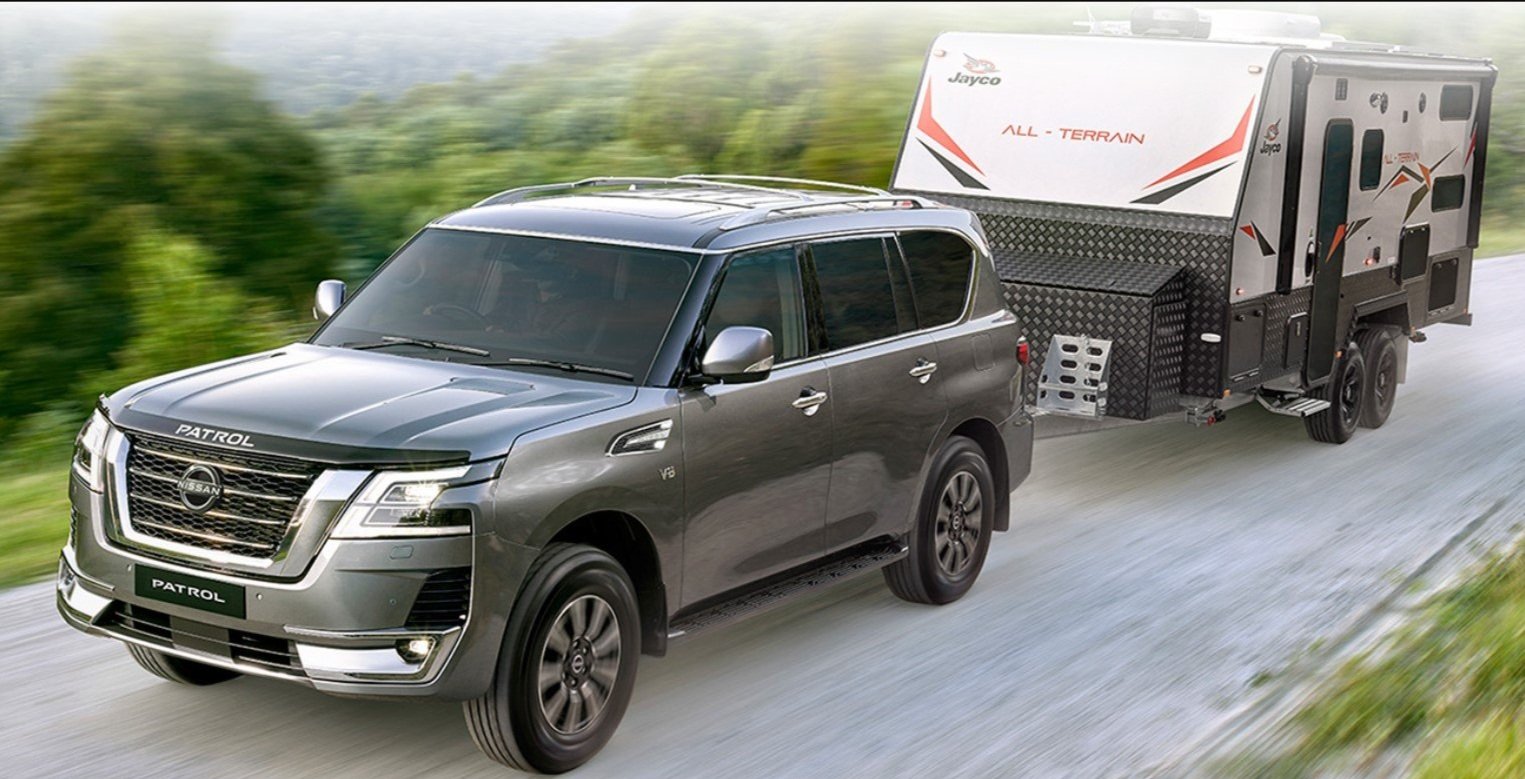

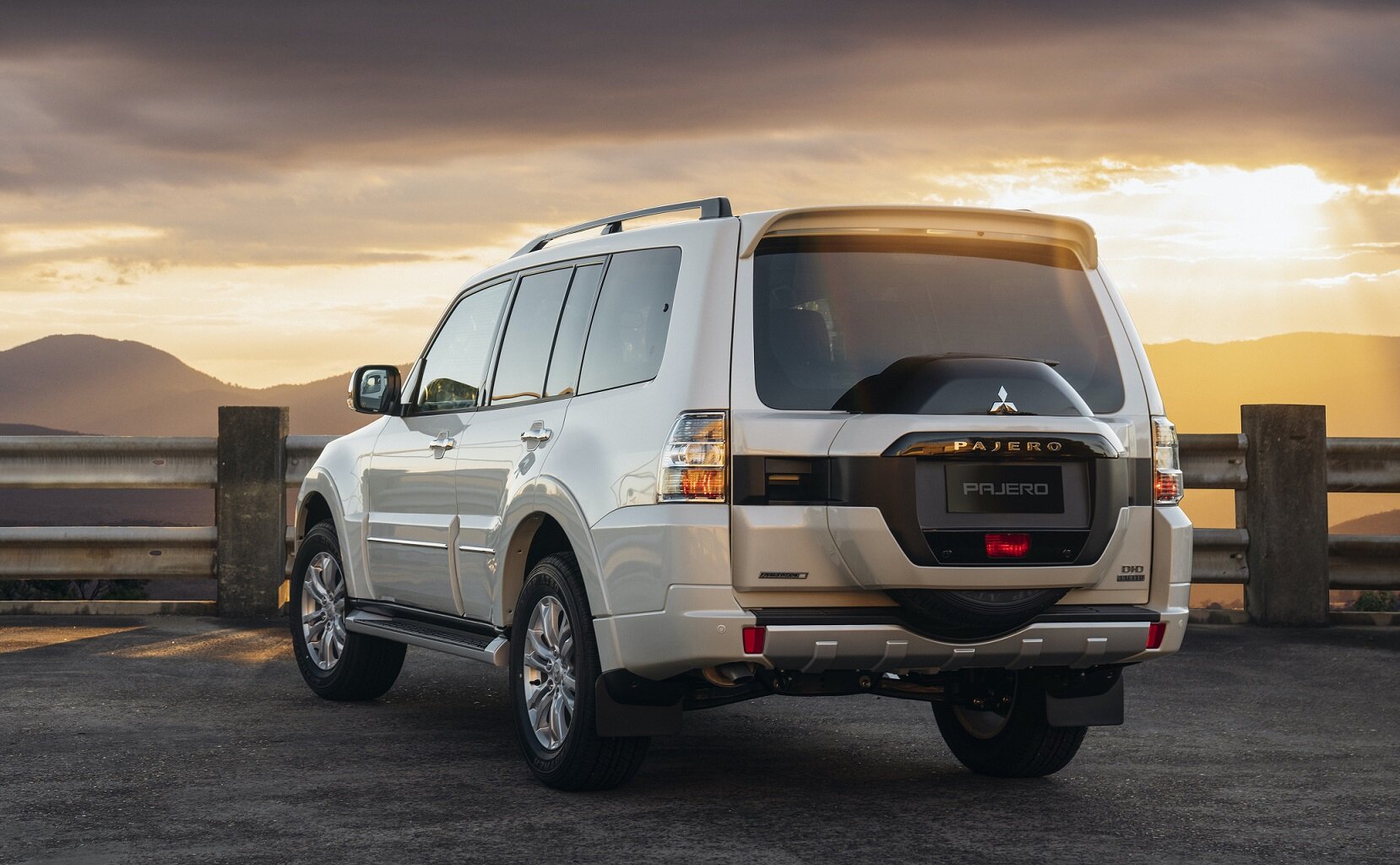
When you take the 270kg from the 700kgs of payload, you might think 430kgs of remaining payload is good.
However, the towbar is not standard, so let's assume it weighs 30kgs (pretty light for a towbar), that comes down to 400kgs. You haven't put any people in it yet.
The kerb weight of the vehicle includes a full tank of fuel, no problem, but you've got to put yourselves in it. Two people with basic equipment, drinking water, food, luggage bags, let’s assume 100 kilos per person and their stuff. You wouldn't have the vehicle completely bare.
Let's include some outback logistics support and equipment before you drive off into the outback. You've got to take communications and a fire extinguisher, a first-aid kit, maybe a second spare tyre, a compressor and a tyre repair kit, your basic recovery gear, a shovel up on a roof rack which also adds mass.
If you just put two people and a little bit of equipment, not including all of that stuff we've just discussed, you've only got 200 kilos remaining. That's without a bullbar yet, and most of you 4WD touring adventurers want to fit a bullbar so you fit in. That's really hard to manage even at 2.7 tonnes.
What if you've got kids? That’s going to add 50kgs per kid with all of their extra stuff. That 200kgs is looking real tight. You could get stopped at any time to be weighed.
Choosing the right tow vehicle is also about choosing the right towing assignment. If you’re going to take an off-road camper, then you’re probably not looking for a brand new vehicle. Are you? If you’re towing a big, luxurious caravan with all the glitzy trimmings, then you’re probably not going off-road with it, are you? You’re going to ditch the ‘van and take the vehicle anywhere moderately tricky.
So find the vehicle that is going to suit your budget, the mission and conditions you’re needing it to be ideal for, and then find the trailer to suit the vehicle. Because if you only do these trips twice a year, the other 300 days of the year, the vehicle needs to perform all other duties, doesn’t it?
Monocoque/unibody chassis towing vehicles includes Toyota LandCruiser 300 Series (of course) and the Prado, the Nissan Patrol, the now defunct Mitsubishi Pajero (production ceased in 2021) likely with a new version to arrive in 2025.
This is why many people opt for dual-cab utes. They serve multiple roles, which makes them good at those tasks, but not perfectly designed to offer you maximum potential on each one.
There are the obvious Ranger, Hilux, Triton and D-Max ute choices, and then their wagon-bodied derivatives like Everest, Fortuner, Pajero Sport and MU-X respectively.
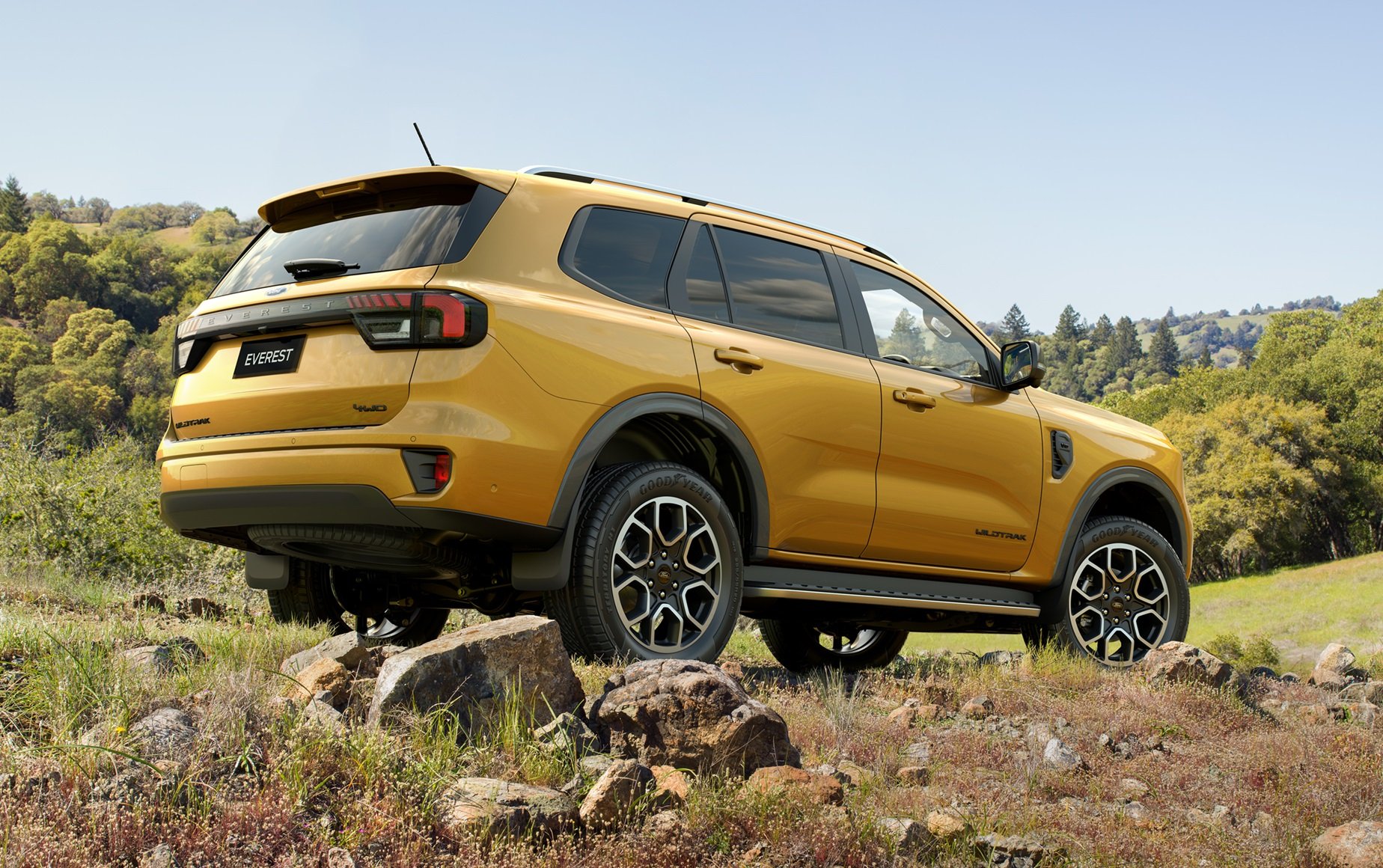
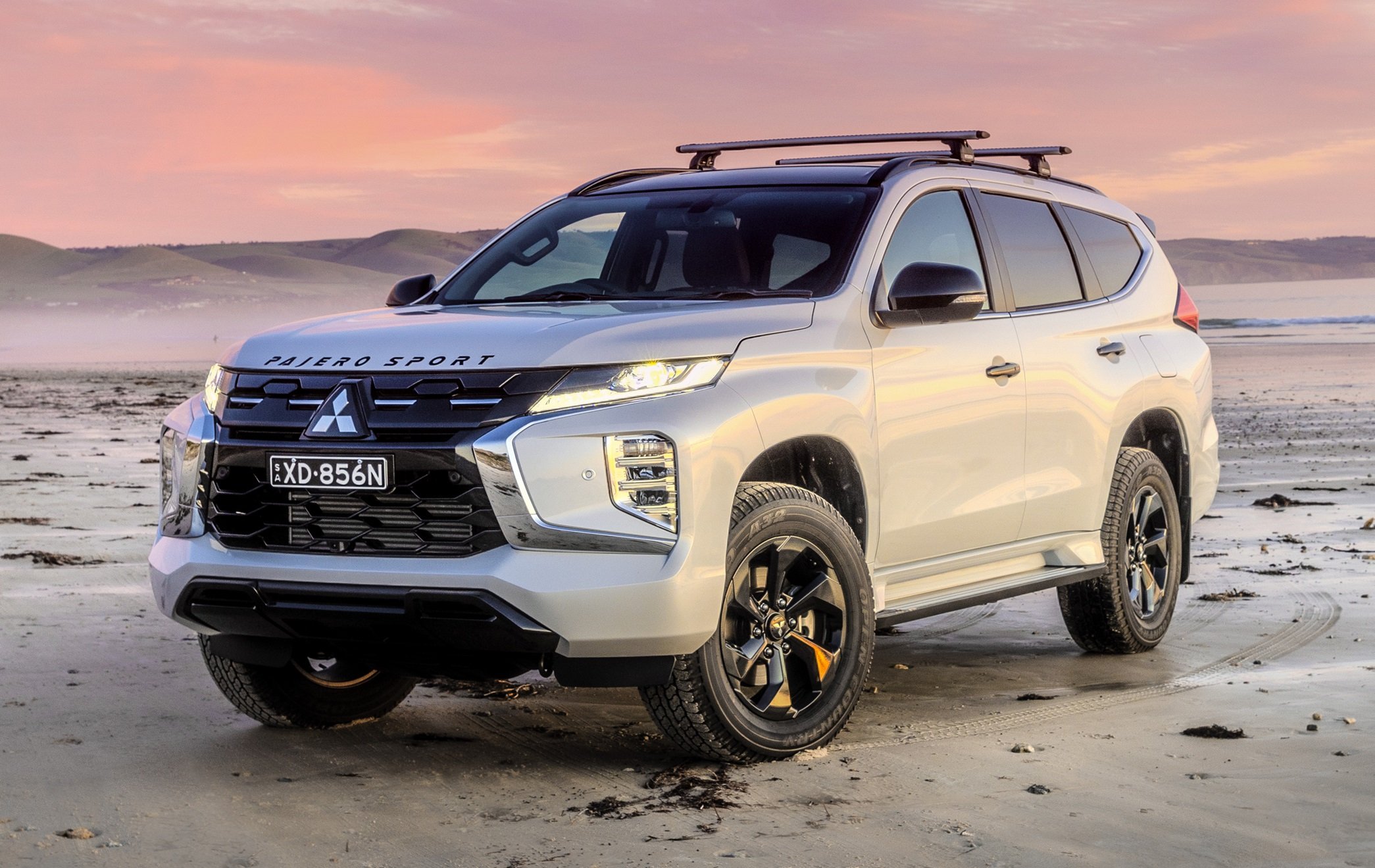
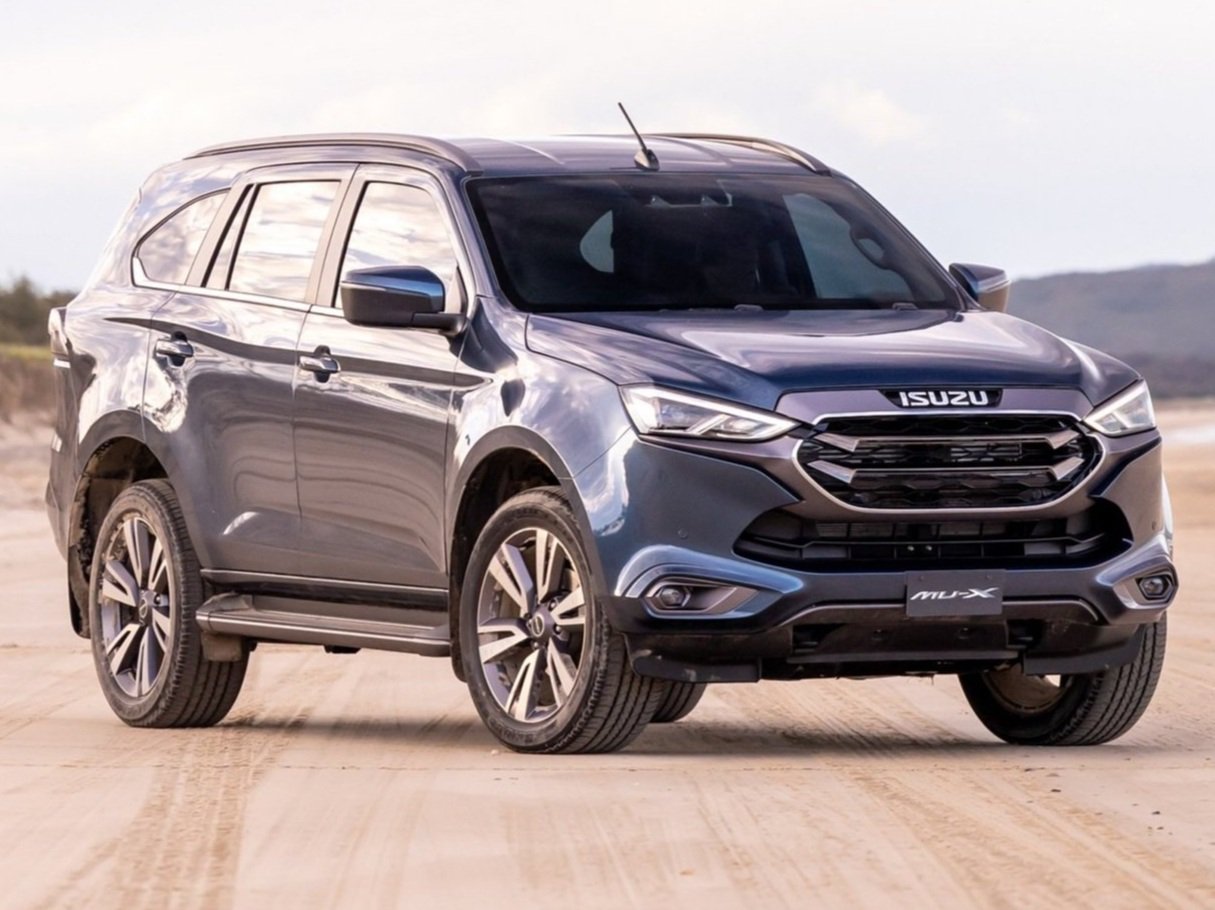
So which should you choose, ladder frame or unibody?
You might presume a ladder frame chassis would better for towing. It’s certainly not always better for rigidity. Unitary construction (like Pajero) is excellent. Hardcore purists don't like it, but they are potentially and generally unaware wombats who don't like change (even change that happened 20 years ago and is now mundane.)
Even with a degree in mechanical engineering it’s hard to justify that ladder-frame chassis is superior in some way, because unitary construction has the potential to deliver the same (or better) rigidity with less mass (and a Pajero, for example, certainly is lighter than a Prado, spec-for-spec).
LandCruiser is the pinnacle of unibody construction and you would hardly suggest it is in some way inferior for towing compared with a Pajero Sport, Everest or MU-X. Ditto for Nissan Patrol.
Basically it depends upon the execution in either case - good ladder frame and good unitary construction will both deliver adequate structural performance, and good unitary construction will deliver it with less weight. It’s impossible to make credible blanket observations like that. There’s no evidence whatsoever to support that 'blanket' conclusion that 'ladder frame tows better'.
In fact, if that were the case, we would probably see a spate of dual-cab utes and their wagon derivates all spearing off the freeway when towing and there would be a public outcry warning people about the dangers. But there isn’t. They’re both quite okay.
The one argument you might make is that the nature of ladder-framed vehicles being inherently longer, generally speaking, means that there is that longer cantilever between where the towball is positioned and where the cabin ends just fore of the rear axle.
That is generally a longer lever and therefore less stable in pitch compared with a unibody where generally you’ll noted the towbar is right up under the bum of the vehicle, and is much closer to the rear axle, meaning there’s less leverage being exerted on the vehicle by the trailer.
Utes do make the towing combination slightly longer, but again, weight is the more important factor. If you absolutely must tow something heavy, match it with an appropriately sized and weighted prime mover.
How much power do you actually need for towing?
Do you actually know how much power you really need to simply drive down the highway? What about towing your enormous caravan into the bush? I’ll bet you have no idea…
And yet, plenty of you hardcore off-roading bogans probably think you need the most powerful utes on the market in order to perform this task.
When you look at engine specs, you see X-many kilowatts, but that’s talking about their peak outputs. When the manufacturer sticks an engine on a dynamometer, they run it flat out, and they record the peak power and torque outputs, and at what revs that happens.
This is useful for measuring peak performance, as in, when you give it hell. This is useful for comparing, because an engine with 200kW and one at 300kW, at 6000 RPM, you can infer that in the mid-range, the higher output engine will be better. It’s not entirely inaccurate - it's not a bad way to compare engines, but it's not representative of how you drive.
Outside of a racing environment or a drag strip or an exceptionally steep hill with a really heavy caravan, you're not using full throttle all the time, against a balancing load - you just don't drive like that.
In fact, you use very little power to do mundane driving, often just two figures of kilowatts, around 30-60 kilowatts, even at highway speeds.
The peak power figures are only there for comparison purposes.
Next, towing limitations are something nobody ever tells you are the weakest link; carmakers certainly do not tell you what the weakest link in their vehicle is. But these peak performance figures, be it power or towing capacities et al., they are based on a weakest link scenario.
The weakest link is unlikely to be the power or torque production of the engine. But it might be endurance related, like the heat capacity of the automatic transmission, because in their R&D torture testing they might tow a dynamometer and an electric load on a trailer to simulate a big caravan.
In this test they might notice that above a particular simulated weight equivalent of, say, 3.1 tonnes, hypothetically, at highway speeds, the transmission might start to overheat.
So, the engineers might suggest that in 10 or 15 years of service - worst case scenario - they'll all be suffering failures of some kind, so they limit the rating to save on the life of major driveline components.
TOWING OFF-ROAD: Consider a truck
This whole exercise is about instability mitigation. Avoiding getting unstable is the Prime Directive from StarFleet.
Nothing frightens an actual truck, especially if you’re towing heavy, and/or off-road.
You want to be safe. You need to keep your family safe, and everybody else’s family, out there on the roads. The best way to mitigate this disaster waiting to happen, is to minimise the mass disparity on the trailer. A proper 4X4 truck will never be pushed around by your dual-axle off-road camper trailer or caravan.
This isn’t as mission-critical for short trips like to a local boat ramp, because you’re probably not going to reach high speeds.
But even at 20-40km/h off-road, you have acquired a huge amount of kinetic energy - enough to tip an ordinary dual-cab ute on its roof. When that energy is dispersed or transformed in a short period of time, that’s bad.
There are geometric deficiencies when driving off-road or on unsealed rural roads with close to 3.5 tonnes on the back. Hitting a hole or trench or a rock or standing water - whatever - you’re going to bleed that energy away very quickly, which can easily damage something - or unsettle the whole combination.
You cannot realistically take 3.5 tonnes for severe off-roading. Pig trailers are not designed to pitch, roll and yaw in extreme ways. Sure, off-road trailers with a Treg hitch (et al.) help in these situations, but they remain limited in how much punishment they can take. As is the drawbar.
Just because the specs say you can tow 3.5 tonnes, that does not make it safe to do so. You need to keep the weight as slow as possible to reduce the amount of energy you carry in your entourage - the more energy, the harder it is to keep under control.
But oftentimes, the 4X4 vehicle might not be able to restrain both the camper and itself, which is why a 4X4 truck is a smart choice. Using an Isuzu D-Max X-Terrain as an example, you need to leave just about everything out of the ute itself if you tow 3.5 tonnes.
With 80 kilos per person on board - which is a very modest estimate of your family’s combined bodyweight - that’s 320 kilos of human, plus 50 for the towbar plus 2130kg for the D-Max’s kerb weight, plus 3500 kilos for the caravan out the back, that equals 6000 kilos even.
That’s 50 kilos over the D-Max’s gross combination mass limit, before carrying a single item in the cab or the tray (such as Jerry cans of fuel, water containers, recovery gear), or fitting a single accessory.
Seriously, consider buying an actual truck. They come in all shapes and sizes, with 4X4, long wheelbase, quad-cabs, with tray packs, automatic transmissions, and you can even have that more appropriately de-tuned 3.0-litre 4JJ engine - or you can have a 5.4-litre version with GVM and payload figures that leave a D-Max for dead.
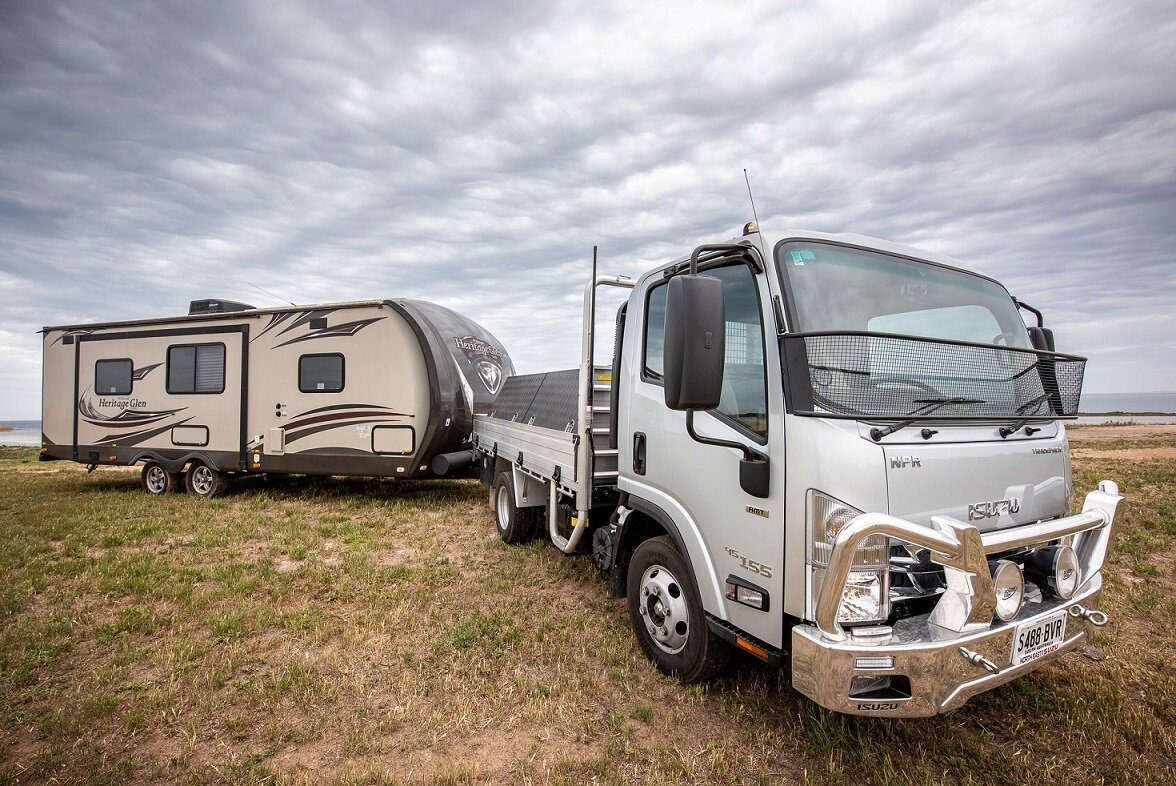

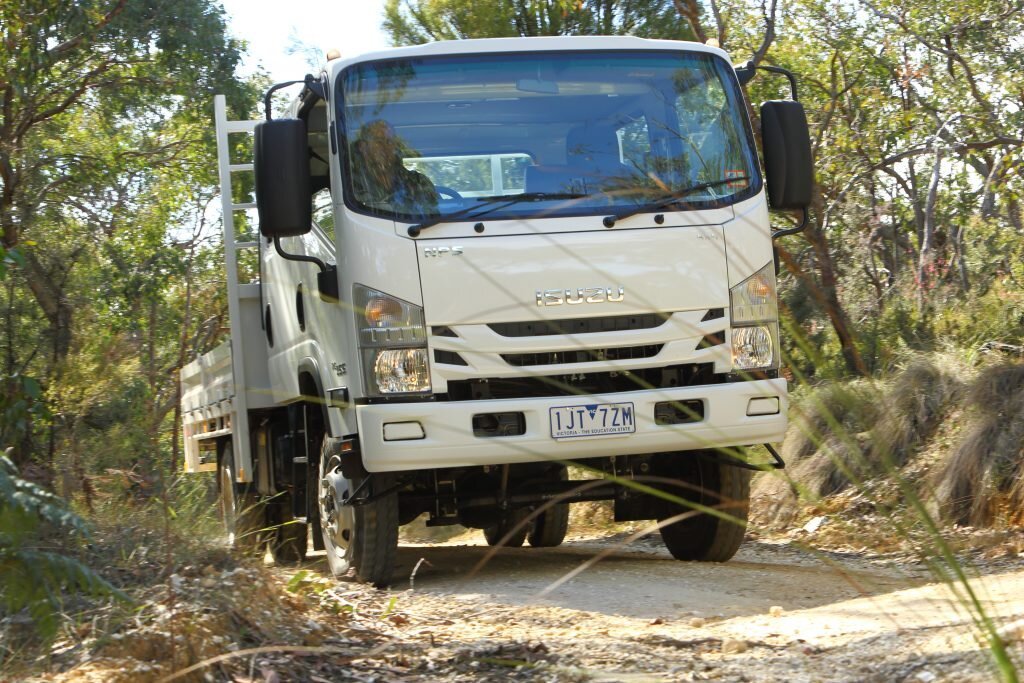
An Isuzu NPS murders a LandCruiser 300, a Ford Ranger, VW Amarok, Pajero Sport and even flips the bird at a RAM 2500, every day of the week. An Isuzu NPS 4X4 will move 3.5 tonnes every day of the week, including public holidays and RDOs - because it’s designed to - safely.
There are companies which will bolt what is effectively a small caravan onto the back of your 4X4 truck. These set-ups are far more tenable and dynamically safer than hauling a 3.5-tonne pig trailer behind a ute. When you consider the cost of a LC300 Sahara and a dual-axle luxury caravan, the 4X4 truck option does start to look quite reasonable. And it’s got two low-range gearsets - which is an argument stopper right there.
There are an increasing number of options for this kind of 4X4 expedition-style overland truck, including Isuzu N-Series, Mitsubishi Fuso Canter and the Hino 300 series.
If you’re not prepared to buy a truck and do this 3.5 tonne towing assignment properly, buy your ute. Just don’t tow anything heavier than 2.5 tonnes. Because physics doesn’t care if you live or die - but the cops do.
I'll help you save thousands on a good towing vehicle
Just fill in this form.
No more car dealership rip-offs.
Greater transparency.
Less stress.
.
PREVENT DISASTER
This crash (in the video below) actually starts when the boat draws up alongside the two vehicles as it overtakes, at about 100 kays an hour. This is a classic venturi.
You’ve got high-speed relative airflow between the vehicles on the left and the ute and the boat on the right.
That sets up a negative pressure well between the vehicles on the left and the boat and the trailer on the right - as evidenced by the boat clearly being sucked left, towards the vehicles, as it passes them. It lurches this way twice - clear as day - each time it passes one of those two cars. And that’s all it takes for disaster to ride on in.
The low pressure is doing the sucking, and the fact that the trailer is unstable in yaw allows it to rotate horizontally in this way. Instant pendulum. There’s really nothing the driver can do about this - except of course know this danger exists up front, and refrain from doing the overtaking move. Clearly, ignorance is not bliss.
Boats are heavy at the back, too, so the boat becomes a heavy compound pendulum hanging off the ute. I don’t even know if the driver had time to get terrified.
It’s 11 seconds from that first lurch to the point where the ute rolls over. I suppose it seemed longer than that, to the occupants. But it’s only six seconds until the first impact. It’s hardly a lot of time for emotional engagement. I suspect the driver was just reactive during the process, but quite shaken afterwards.
I imagine him fighting each lurch to the side with a counter-steering move - like, a bit of opposite lock - which, unfortunately, in this case, just feeds back into the system and makes each subsequent lurch of the pendulum even bigger.
Four-and-a-half swings into it, after the very first left lurch, the right edge of the trailer hits the guard rail. But crashing was a done deal six seconds before, in terms of the process.
The amplitude of the pivots is still increasing after that first impact, and the guard rails just do a superb job. They prevent any impact with trees, and the combination doesn’t slip down into the gully. So, well done there, civil engineering.
There are actually four separate guard rail impacts, and there’s a lot of sliding sideways towards the end - both of which extend the time duration of the collision and reduce the loads on the participants. In other words, that part of the system functioned exactly as it should have. I’m talking about the road infrastructure.
And, fortuitously, nobody was coming the other way at the time, and it appears nobody was hurt. Pretty terrifying experience for the dudes who were overtaken, too, I imagine.
So, what can we learn from this? Here’s six preventative towing tips.
Number One: Minimise the mass of the trailer relative to the vehicle towing it. I know size matters, but when it comes to trailers and safety, smaller is definitely better, and it terrifies me the people who e-mail me direct and say, basically, that they want to tow three tonnes with the smallest vehicle possible, because it’s also their daily driver.
That’s nuts. If you want to tow a heavy trailer, get a heavy vehicle. This is the fundamental stability solution. Personally I think it’s fairly insane to tow a trailer heavier than the kerb mass of the vehicle towing it. I bought a trailer recently with a two-tonne ATM for the Triton GSR, for exactly this reason. It’s the heaviest trailer I’m prepared to tow with that vehicle, despite its 3.1-tonne tow capacity.
I’m conservative like that - mainly because I don’t want to wake up, parked on the side, in the middle of the road, with the trailer in front of me. Call me old fashioned.
Number Two: Get the trailer and the vehicle set up right, with five to 10 per cent of the loaded mass of the trailer as the static towball download. That’s ideal for stability. And boats are so difficult here, because the heavy components hang off the rear. Measure the weights - do not guess, or read them off a spec sheet. Visit a weighbridge and do this right.
Number Three: Drive conservatively. That means, knock 10 or 15 kays off how you’d normally drive (conservatively). It can feel quite OK towing heavy at 100 - but it can also come unglued very rapidly, as you’ve seen. Just change your mindset here, and for Christ’s sake, let faster vehicles past at every opportunity. There’s no need to ramp up the tension on an already struggling road system.
Number Four: Leave some ‘acceleration juice’ in the tank. Meaning: one of the reasons the driver of this ill-fated towing assignment crashed out is that if you drive a trailer and it starts to get the death wobbles, the best move is: accelerate gently and don’t try counter-steering. (Because acceleration reduces amplitude, and counter-steering often causes the amplitude of the subsequent swing to increase - and you only get about four swings until it’s all over, at speed, right?)
Our ‘hero’ here was accelerating at the maximum potential of the vehicle for the overtake. And, with no more acceleration juice in the tank, he was unable to gently tug the pendulum forwards, to reduce the amplitude of the next swings.
Number Five: Get some driver training. This trains you to look as far down the road as possible, which is generally where you want the vehicle and the trailer to go, in that order. Under pressure, you generally steer where you’re looking and it’s less likely you’ll over-compensate with the steering.
It goes without saying you need to have both hands on the wheel at nine and three, not be half asleep, have the seat properly adjusted, and the mirrors, be situationally aware, and check your tyre pressures. That’s the price of admission. I should not have to say this. And yet, here we are.
Finally - Number Six: If you’re upgrading the vehicle, get one with a ‘trailer anti-sway’ algorithm built into the electronic stability control system. Computers are generally better at this than most/all drivers. Not only do they detect the problem and intervene sooner, but they also intervene better, by cutting power when it’s needed and applying the brakes to individual wheels to generate the yaw response needed to cure the problem.
Note that I did not just say: ‘Get trailer sway control and then it’s OK to go back to driving like a dick.’ The safest systems are the ones with the best systematic safeguards available, and the highest level of operator vigilance as well.
Plus, these trailer sway systems are aids - they do not guarantee to insulate you from any and all trailer sway situations. With big-enough inputs you can overwhelm the vehicle’s system sufficiently to get out of control.
.
KNOW YOUR LIMITS
Payload, GVM, towball download
The insane automotive arms race for outright towing capacity king needs to stop. But it wont. Meaning, the onus is on you to do the right thing.
Attaching a caravan, trailer, horse float - whatever - is a safety and risk management issue and this enormous towing-assignment obsession is out of control and it should be the greatest concern to you as the licensed driver.
It’s delightfully liberating to blame someone else for your problems, but I think consumers are mainly responsible for pushing demand out to carmakers for wanting to put vast caravans, RVs, camper trailers on the back of their vehicles and head into the bush. And manufacturers of those trailers, and camakers, are largely complying with that demand.
If camakers and recreational vehicle manufacturers stopped meeting that demand, the aftermarket industry, I’m sure, would step in to provide solutions to consumer problems. In many cases, there are businesses already stepping in to do that, with things like GVM upgrades.
If you want to tow something very heavy, the industry isn’t going to step in and emphatically warn you, Mr & Mrs Consumer, ‘that’s a bad idea’.
If you want to understand towing at a deep, meaningful level - like a professional - and you don’t want to be a complete berk about it, you need to understand the basic terms, and how to run the numbers on your rig. (It’s also helpful if everyone uses the same, correct terminology).
When towing, you need to know your limits.
Here are the terms and what they mean:
Tare weight: Empty vehicle, with 10L of fuel
Kerb weight: Empty vehicle, full tank of fuel
GVM (Gross Vehicle Mass): Maximum permissible weight of the vehicle, fully loaded (kerb weight + additional load).
ATM (Aggregate Trailer Mass): Same as GVM but for your full loaded box trailer/caravan/float/boat trailer/camper, maximum permissible weight.
Towball download: Important: amount of vertical load the static trailer imposes on the towball - we’ll get to that - this must be deducted from the vehicle’s payload when doing your calculations.
GCM (Gross Combination Mass): The maximum permissible weight of a tow vehicle including trailer - absolute ATM and GVM weight limit.
Payload capacity: The maximum a vehicle can carry on-board, including a full tank of fuel, passengers, luggage, accessories and towball download.
In this report I also discuss the towing 'arms race' in which people think it's okay to tow a 3500kg trailer with a vehicle that weights 2500kg-ish, and this is often a very bad idea, in my view.
I'll talk you through the payload limitations in the common vehicles and also discuss how you can actually measure your critical weights using a public weighbridge, to ensure you're not driving overloaded - which has important safety, legal and insurance implications.
Also discussed: GVM upgrades and warranty, and the effect of adding accessories on your payload capacity.
Next time you see the stereotypical Taj Mahal caravan and 4x4 wagon entourage barrelling down the highway, heading into the sunset, take a second to observe.
How much does that van weigh? How much payload have the Grey Nomads or cashed-up bogans shoved in the back, including people, luggage, bullbar and roof rack, jerry cans, banjo etc. Perhaps this is you, rolling the dice with safety with your kids in the back and others beside you at 110km/h.
Just because you’ve bought the top-spec Ranger Wildtrak or LandCruiser Sahara, does not mean you can hitch up to some small moon and it’s all good. The numbers and physics matter here.
Wagons are typically GVM limited. Take the LandCruiser 200 Series, with a 3350kg GVM. Minus its 2740kg kerb weight, leaves you with 610kg of payload, with a 350kg towball download limit (based on that heroic 3.5-tonne braked towing capacity). You’re left with just 260kg of payload. Divided by four people (mum, dad, two kids, for example), that’s 65kg each person can weigh.
You’re going to be dangerously overloaded, I’d suggest.
Similar goes for the Ford Ranger Wildtrak; it might be the trophy truck of your dreams, but it’s not the last word in heavy towing. Here’s why.
A 3.2 automatic Ranger Wildtrak has a 6000kg GCM. Minus the 3500kg ATM (because everybody who owns a Ranger has to be a hero), and you need to deduct the 2278 kerb weight. You’re left with 222kg of permitted payload. Divide that between two adults and two kids: 55.5kg. Between mum, dad and one kid: 74kg each. Just single lads [Tradie 1] and [Tradie 2], that’s 111kg each can weigh.
Whatever you add to your vehicle in terms of payload and accessories, all pushes toward the GVM limit. Here it is in real terms of what you might realistically pack, fit, and buckle up:
People: 3 x 80kg p/p = 240kg
Towbar: 30kg
Bullbar: 40/80/110kg
Fuel: 20L (roughly 20kg per jerry can) + Water: 20kg
Tools: Sockets & spanners, hammer, spade, light-duty air compressor: 20kg
Luggage: 20kg
Additional spare tyre: 20kg
Miscellaneous: (first aid kit, UHF radio, wallet, phone…) 20kg
= 500kg
This is fairly conservative packing. Half a tonne. It’s very easy to exceed your payload limit.
WEIGHBRIDGE & SCALES
I suggest you find your public local weighbridge in your area and trod off to it with both your vehicle and trailer in their most heavily laden configurations.
Drive the trailer onto the weighbridge, decouple, get the jockey wheel on the ground, and drive the tow vehicle off. Take the measurement #1.
Then recouple, and drive the vehicle off so its wheels are not on the scales, but the trailer is. Take that measurement #2.
Then drive off, uncouple, and drive the vehicle back onto the scale in its heavily laden configuration, including passengers. Take that measurement #3.
You can now figure out the gross combination mass by adding together Measurement 1 (ATM) and Measurement 3 (GVM). The result is your current GCM. Compare that with the GCM limit specified by the manufacturer, and you know whether you’re under it, or if you need to leave something behind.
You can also determine your towball download by removing Measurement 2 from the Measurement 1 (ATM), then compare that result to the limit on the vehicle to ensure you’re not over it.
Most people don’t measure this, and just hope for the best, which is insane.
If you want to get your GVM and GCM as right as possible before heading to the weighbridge, here’s what you do.
GVM = kerb weight + towball d/load + vehicle payload
OR Payload = GVM - kerb weight - towball d/load
GCM = kerb weight + ATM + vehicle payload
Payload = GCM - kerb weight - ATM
You can work backwards on these equations to confirm things for yourself before heading out on the road to the weighbridge.
You can also buy yourself a townball download scale from any auto parts retailer.
.
HOW TO TOW SAFELY
This is so much more complicated than taking a baby box trailer to the tip - the details really matter if you want to avoid getting yourself on the nightly network news.
There’s no doubt towing a big heavy trailer, particularly in an urban environment on an arterial road with reasonably narrow lanes and crazy trucks screaming past, can be quite demanding.
You’ve got to have a constantly updating picture in your head about what’s going on around you at all times, and you have to solve all the problems down there from up here, in the cockpit. You have to be ahead of the curve.
But many people think the heavy twing equation plays out in the driver’s seat, however, you need to get everything right way back at the start, or it can end very, very badly.
TRAILER SETUP: Do pre-flight checks
Heavy towing actually starts with the vehicle and trailer configurations and you need to get them right. Heavy towing starts long before you’re even left your driveaway.
You must conform to the numerous load limits and you need to optimise your particular setup for ultimate dynamic stability. This is a really specialist thing, so get expert help if you need it - DO NOT WING IT.
Your trailer in its most heavily loaded configuration needs to conform to its own Aggregate Trailer Mass (ATM) limit. It also needs to come under the vehicle’s maximum legal tow capacity and maximum static towball download limit of your vehicle.
You’ll likely need to consider weight distribution and possibly learn your way around load levelling hitches >>
There’s also the Gross Combined Mass (GCM) limit, which is the total combined weight of both the loaded trailer and your vehicle.
Then there’s the total Gross Vehicle Mass (GVM) limit which is the total loaded weight of the tow vehicle - including passengers, luggage, equipment, accessories and the towball download limit (do not overlook this) - and it’s a lot of complex stuff to keep track of if you’re not a technically trained person.
You need to ensure these loads are legal too, using a weighbridge and PRO TIP: do not guess this: measure this.
Overloading any part of your setup is dangerous, illegal, negligent, and pretty stupid. If you get stopped and weighed out there on the Australian roads and you’re found to be overloaded, at the very least a fine will be coming your way and you won’t be proceeding.
If you crash while overloaded, and they figure it out (which they will), your insurance company might make taking out a claim very difficult indeed.
Once you’ve ticked all these compliance boxes, you’ve then got to get all the pesky little details right.
MEASURE EVERYTHING
It’s vital to measure you towball download, because this is the direct influence of the trailer upon your vehicle.
I suggest you find your public local weighbridge in your area and trod off to it with both your vehicle and trailer in their most heavily laden configurations.
Drive the trailer onto the weighbridge, decouple, get the jockey wheel on the ground, and drive the tow vehicle off. Take the measurement #1.
Then recouple, and drive the vehicle off so its wheels are not on the scales, but the trailer is. Take that measurement #2.
Then drive off, uncouple, and drive the vehicle back onto the scale in its heavily laden configuration, including passengers. Take that measurement #3.
You can now figure out the gross combination mass by adding together Measurement 1 (ATM) and Measurement 3 (GVM). The result is your current GCM. Compare that with the GCM limit specified by the manufacturer, and you know whether you’re under it, or if you need to leave something behind.
You can also determine your towball download by removing Measurement 2 from the Measurement 1 (ATM), then compare that result to the limit on the vehicle to ensure you’re not over it.
Most people don’t measure this, and just hope for the best, which is insane.
If you want to get your GVM and GCM as right as possible before heading to the weighbridge, here’s what you do.
GVM = kerb weight + towball d/load + vehicle payload
OR Payload = GVM - kerb weight - towball d/load
GCM = kerb weight + ATM + vehicle payload
Payload = GCM - kerb weight - ATM
You can work backwards on these equations to confirm things for yourself before heading out on the road to the weighbridge.
Caravan buyer’s checklist
Whether you’re completely virgin or a so-called veteran of caravan buying, the Caravan Council of Australia has a two-page, 27 question checklist that makes caravan buying properly sensible.
It's full of important questions most people simply would not think to ask either the caravan dealer, or the private seller, both of whom are incentivised to tell you everything you want to hear when potentially shopping for a new mobile home-on-wheels.
This checklist comes from the Caravan Council’s CEO who is a professional engineer, not just a self-appointed enthusiast who spends too much time on social media and forums spouting uninformed opinion. He’s qualified to offer you advice when buying into this popular, expensive and potentially dangerous hobby.
Watch the video below and download the caravan buyer’s checklist here >>
If you’re planning to tow a trailer off-road, check out the AutoExpert Ultimate Off-road Guide here >>
LOAD POSITIONING
For reasons that should seem obvious, how and where you position your cargo both inside the tow vehicle and inside the trailer/caravan/camper etc are vital.
The heaviest items need to to be stowed as close to the centralised axles as possible. Lighter cargo should go as far rearward as possible, but only if you have medium-sized items that can go forward of the axles.
See diagram below:
Source: Toyota Towing Guide
Do yourself a favour by digesting the Toyota towing guide. Type into Google: Toyota Basic Towing Guide. It’s 12 pages long with good advice for setting your trailer up and corroborates a lot of the info in this report.
If you have extremely heavy cargo, perhaps reconsider your vehicle choice.
If you want to tow something weighing more than 2.5 tonnes, don’t buy a LandCruiser or Ranger, or Pajero Sport or Nissan Patrol. Buy a truck. Seriously.
A small truck like an Isuzu NPR or Hino 500 or Iveco Daily 4x4 are all perfectly suited for towing really heavy loads safely.
Or better yet, for the cost of something like the six-figure Zone RV or its counterparts, you could stay in really, really nice accommodation just about anywhere for years and still own a very comfortable car to travel around in.
And you don’t have to tow anything, you can have your meals cooked and there’s no emptying the toilet in the searing heat.
There are a few compelling cases for towing those big caravans or very heavy trailers.
If you do get the Taj Mahal, you can tow it somewhere once, install it semi-permanently at a caravan park, and leave it there, while touring around while you’re there. That’s fine.
Or, if you have a big boat, you can take it every second or third weekend from your house to the boat ramp, with minimal payload in the back of the vehicle, and enjoy the local waterways. That’s not very demanding because you’re light on gear, the boat’s not overloaded, and the driving task isn’t particularly demanding on the vehicle (and its powertrain) and the underpinnings of both trailer and tow vehicle.
And the last scenario where super-heavy towing assignments make sense on one of these vehicles, is if you’re some kind of contractor or tradie, you might have a medium-size excavator or bobcat which just tips the scales at 3.5 tonnes. Occasionally you need to move it from site to site to get the job done - you’re not doing several hundreds of kilometres, and you can probably do those short trips within your local geographic area, more or less. That makes sense.
But for everyone else, particularly the Grey Nomad fraternity, GVM upgrades are insanity, the tow vehicle weighing significantly less than the trailer - flat-out stupid. Make some airline reservations, check-in at a hotel or B&B, or buy a small truck which will carry you around the country much safer.
You clearly have the cash.
TYRES
Make friends with your tyre gauge here too, because there are no less than 10 tyres in this situation with a dual-axle car trailer.
PRO TIP: While you’re doing both vehicle and trailer, make sure you check all spare wheels as well; do it before packing the boot.
DO NOT SKIP THIS STEP. Under-inflation is the most common cause of blowouts.
Most people at this point also don’t bother checking, but check all your lights, every single one.
Especially check indicator lights and brake lights.
Now secure that load. Whether it’s bikes, a car, boat or jetski or even a bobcat - you do not want that load shifting or moving in transit, or coming completely unglued during a swerve or emergency brake application.
It also doesn’t hurt to double-check all this setup stuff before setting off, or have a second person review your setup with you to make sure you’re not about to score an epic own-goal because you had brain fade or a senior moment.
RESTRAIN & SECURE: Do a systems check
Some vehicles can be easier or harder than others to dock your vehicle with the trailer as reversing cameras and sensors vary, but many upper-spec utes and large SUVs come with a clever dynamic towball guidelines which move with the steering.
You hook up the trailer, getting the main trailer handle locked down on top of the ball and you do this immediately because it’s easy to forget. It’s a priority to do this straight away, get the pin locked down because it’s also embarrassing if it comes off out on the road.
Immediately lock down the hitch; even adding a spring-loaded lynchpin is an extra layer of safety any flatbed towing operator would recommend.
Next, there are two safety chains for heavy trailers. Cross them over diagonally. The left chain goes on the right towbar anchor point and vice versa. Make sure you use load-rated shackles, they’re the ones with yellow pins.
If you have trailer breakaway protection, designed to immediately apply the brakes in the event the whole thing decides to part company, make sure you clip the end of the lanyard to the tow bar - not the chain. (Because the breakaway system won’t work, obviously).
Now, double-check all your lights are functioning correctly. Don’t think of this as just a lights check, this is a systemic communications check with the vehicles around you. These lights are your way of communicating to other drivers: if they don’t know your intentions, you are the cause of whatever unfolds next..
.
THE DRIVING PART
Automatic transmissions
There is a bad driving trend out there that suggests you can use the transmission to retard the vehicle’s speed, particularly on downhill runs.
Brakes are cheap - cheap. Brake pads are cheap, brake rotors are pretty cheap these days. But transmissions on the other hand, are very expensive. They’re break-the-bank expensive, in many cases, particularly on late-model vehicles.
Transmissions on cars are not designed as a substitute for the brakes, therefore you’ve got to use the brakes to slow the vehicle to the desired speed - not the transmission. That's the general idea when you're towing. Not even towing, just driving generally, including cars, utes, SUVs - whatever.
Certainly, you can hold the vehicle in a lowest gear and it will provide some small amount of retardation on a protracted descent, and that's not a bad idea immediately, but just use the brakes first. Use brakes to get to the target speed, to do what they were designed to do, which, by the way, is what the manufacturer intended for them to do. Brakes slow the vehicle down.
Got it?
If you’re towing something, drive conservatively, especially if you’re driving down a mountain. But the trailer has its own brakes, generally, and the system is quite robust if you don’t abuse it.
As for ascending, and pre-selecting a lower gear, if you want to save the vehicle stress, don’t tow anything. Translation: you’re towing a heavy load, this inherently puts stress on the vehicle; it’s up to you to not overdo it and be conservative. You’re not driving a tugboat, so don’t try to pull the Ruby Princess out of Darling Harbour. Go slow. Don’t overwork the system by trying to haul 2.5 tonnes up long, steep hills at 100km/h on a 35-degree day.
Powertrain control modules are programmed by engineers who do this towing business for a living, to select the right gear for the prevailing load and demand. Pre-emptively selecting what you call a ‘power band’ is generally insane.
Let’s say you’re on a highway and you get to a hill. Load increases thanks to gravity. You add throttle. The powertrain module does its arithmetic, balancing load (from gravity) versus demand (how hard you’re applying the throttle).
Once it determines you’ll get a better result in a lower gear, it downshifts - which is what a bunch of brainiacs designed it to do. (They also call them ‘Sealed for Life Transmission’ but that doesn’t mean they’re invincible).
So, out of deference to the brainiacs and them understanding the system better than you, just let the transmission decide in the overwhelming majority of cases.
During ascents, let the computer do the thinking. It’s been designed to do that. If it needs to change back, it will.
Tall gears
Finally, on overdrives and towing: fifth and/or sixth gear, and heavy loads.
Gearboxes are about load and speed, right? Torque and speed. First gear gives you a lot of effort at the wheels, at low speed, for not all that much effort by the engine. It’s about mechanical advantage, like a lever.
Example: on the flat (no trailer) you can slip the clutch in first gear and get rolling, using just the torque at idle. Try doing that in fifth. Good luck. (Because fifth gives you a lot less effort at the wheels - because it’s designed for speed. Less effort; more speed.)
Effort and speed are in inverse proportion in powertrains, right? Lots of effort goes with lower speed. Lots of speed goes with low effort. Lower gears tend to be more robust, because they’re transmitting a lot of mechanical advantage.
Higher gears tend to be less robust because they’re all about low-load driving. You’re doing 100km/h with not much throttle, unladen. Then you add some heavy caravan, but it’s also full of your cargo, isn’t it?
So, you’re taking your recent sewage collection on a sightseeing tour of this fine nation at 100km/h. Lots of additional rolling resistance and aerodynamic drag now, of course, all going through fifth or sixth gears, which are not all that robust, typically. Because they’re just for cruising at light loads.
Then, because you think you know better than the brainiacs who actually designed your vehicle, you’re in manual mode. Because you know better, right? You’re in charge.
You get to a slight incline. And you put your foot down a little to compensate. And it gets a little steeper, and you put your foot down a little more. And the transmission is thinking: ‘Gee, if only he’d let me make the decisions here, I’d take a bit of load off, by knocking back to a lower gear.’ But even if the transmission could speak, you would not listen. Because: Napoleon.
Eventually, over time, doing this - knowing better - fifth or sixth gear goes ‘ping’, rather loudly, one memorable afternoon outside cell-phone range, and then you’re sitting on the side of the road with your lovely wife, who is entirely sympathetic to your predicament, just the two of you looking forlornly at Dingo Piss Pass on the horizon, and cursing the vehicle manufacturer for getting the design so horribly wrong.
It’s almost poetic.
If you want to drive with overdrive off when long-distance touring beyond West Bumfark - that’s quite okay.
One of the best ways to reduce load, however, is just to drop back from 110 to 90. That’ll cut aerodynamic drag by about 50 per cent. And aerodynamic drag will be roughly half of total load at those speeds. So, that’s roughly 25 per cent less load on the transmission, and about 25 per cent better fuel economy. All other things being equal.
Also, don’t get ‘advice’ from forums, because they’re rancid breeding grounds for the Dunning Kruger effect. The dumber they are, the more prolifically they comment, typically.
For towing, if you must, the best advice would be: choose the right vehicle, load it conservatively, well below the GVM, ATM, and GCM limits, and leave the damn transmission in ‘D’ for all but truly exceptional driving circumstances. Do this all the way home.
BEING PRESENT
In the real world, you’re never in a static driving environment. You will be in multiple lanes of traffic, you have countless sets of lights, countless bogeys coming at you, surrounding you at every intersection, every hill, at every waypoint. You will climb and descend, and depending on the weather, your ability to keep the entire combination in-check at all times will be tested, and equally, this will be a test of the powertrain.
At no point in time is towing a benign exercise. Just like exercise is not benign, otherwise you’re going to get an injury.
The drive should involve your full focus, at all times, in all conditions, not just in the suburbs or getting across town - your focus needs to include the main arterial highways at 80-110km/h, you need to be on and ready on every old B-road, and even when the powertrain is set to cruise in the towing situation.
There’s actually another two parts to towing, aside from the trailer. They are ‘the vehicle’ and ‘you’. So let’s talk about them in that order.
When you’re towing at pretty much the maximum towing capacity for a vehicle, you are intrinsically closer to the limits of the handling-control envelope. It’s very easy to step over the line and if you do, it’s extremely difficult to recover.
There’s a line and you are driving close to it when you tow - but you cannot feel or see it. You are closer than ever to losing control of the vehicle compared with ordinary driving. But that’s not the only problem.
The trailer is wide and heavy, and it has such an impact on the car at all times - again, even if you can’t see or feel anything malignant going on. This influence is invisible.
You have to be switched on, ALWAYS. DO - NOT - SLACK - OFF.
Be aware of the extra width, drive conservatively, leave muuuuch longer safety margins between you and the vehicle in front, you’ve got to know what’s behind and to the side of you at all times, and you have to fit into very narrow lanes particularly in suburbs on arterial roads which have been increasingly widened by narrowing the lanes.
Then you have roundabouts and so on…
VISION
My strong advice is to drive far more conservatively than you believe to be absolutely necessary.
If you think you’re driving a bit too conservatively then you’ve probably got it pretty right, because you never know when some malignant influence is going to militate against you out there in traffic. Something as ordinary as a ladder falling off a tradie’s van can end your holiday - or worse.
So keep your eyes up, look as far up the road as possible. This is what will give you reaction time, and space, and eases the pressure on you to respond if something goes wrong up ahead. It’s your insurance policy. Time.
Increasing what you can see also allows you to make lots of tiny ‘Plan Bs’, like miniature dress rehearsals for what you’re going to do if X, Y or Z happens… now.
As for driving techniques, you’ll want to turn wide and late. In other words, start left turns on the right edge of the lane and vice versa, and commence the turn after the rear axle of the tow vehicle passes the intersection.
On curves, remain out wide and turn-in relatively late. Use mirrors to monitor how well the trailer is maintaining lane discipline, and adjust accordingly.
If you’re travelling on three-lane arterial roads, stick to the middle lane where you can and remain dropped-back from the vehicle in front no matter how many times you get carved-up/overtaken in traffic - it’s going to happen, accept it, and maintain that safe distance as if there’s a gun to your head.
If you’re driving a manual transmission, do not strain the gearbox in too-high a gear. Don’t make it lug in fifth or sixth uphill - that’s a great way to overstress the transmission and turn what was a perfectly serviceable geartrain into expensive shrapnel.
If you’re driving an auto, for Christ’s sake, leave it in D. It’s programmed to make damage-proof gear selection choices, and you’re probably not going to be as good at this as the computer - so don’t try to be.
PRO TIP: Autos are even more expensive to repair - you’ve been warned.
CONSERVATISM
Safe towing practices don’t just apply to the brawniest of vehicles or the most experienced of drivers, obviously. It applies especially to the less experienced, and anybody driving softer vehicles like large SUVs where the kerb weight is lower but the proportions of the towing assignment remain substantial.
Towing assignments such as car trailers, being pulled by prime movers much closer to a 2-tonne kerb weight need to be managed with equal degrees of conservatism owing to that invisible limit, discussed earlier, being much closer than in something like a LandCruiser or Patrol.
This is actually a very serious tow test for this vehicle (pictured below) - the Santa Fe’s maximum tow capacity is 2000kg, the i30 Fastback N here weighs 1470kg.
Add in the 500kg weight of the trailer, you hit 1970kg and we’re within 30kg of the limit, which is pretty close. The limit here is not just an imaginary ceiling, it’s an edge you do not want to step over.
In practice, if you can come in 20 per cent under the maximum tow capacity for your vehicle that’s probably the sweet spot to give the powertrain some lee-way, and it’ll give you more flexibility in terms of whatever equipment you might have inside the boat, car or caravan, or whatever it is you’re towing.
The other thing which makes this particular Santa Fe pretty good at towing is the genuine load assist kit, which gives you a set of upgraded, variable-rate springs which deliver 50kg more in the towball download limit, going up from 100kg standard to 150kg with the kit.
It also means a ride quality benefit when not towing but the vehicle is loaded up because the variable rate on the springs accommodates extra loads very well.
The $2500 kit also gives you an electronic brake controller which allows you to tweak the response to trailer brakes in relation to using the vehicle brakes - very useful when you’re up close to the limit.
It’s good to make the brakes more responsive on the freeway and slightly less responsive when you’re driving around town. It’s just a twirl of the knob and you’re not locked into some mechanical feedback loop you’d be in with the older style of mechnical brake controller.
All up, this is a very serious test and the vehicle has kicked it through the big posts on the full.
SPEED, FUEL CONSUMPTION & DRAG
The unladen weight of a New Age XU caravan is 2973 kilos, according to them. That’s before you put all your gear in it. Once you add crockery, appliances, bags, fill the water tank, add a gas bottle, bedding, bikes etc, it's a 3.5-tonne box on the highway doing 110km/h.
Costing over $80,000 for the base-model (probably $100k by the time it’s on-road, with all the features you want), to tow something so preposterously big and heavy, you need a LandCruiser or Nissan Patrol, because it’s too heavy for a ute. And even then it’s a stretch.
The only reason you would consider aerodynamic drag with this $200,000 combination is for fuel consumption. If you’ve got 200 grand, disposable, then fuel is cheap, but let’s look at drag anyway.
It is absurdly dangerous to tow 3.5 tonnes at 100km/h, when 80km/h would make far more sense, by not risking your own life and the lives of those around you. As a side benefit, aerodynamic drag would also drop by roughly one third.
Reducing speed will not just save you fuel, reduce wear and tear, and increases your reaction time to changing traffic conditions up ahead, it also means slowing down or emergency braking is a much safer undertaking in the event of something going wrong.
SUSPENSION & STABILITY
The instability threshold of any caravan or camper trailer is obviously beyond the remit of most caravan owners.
They're really not in a position to advise or encourage other drivers about stability. What they're in a position to do is offer their opinion to say something like, “Well, the way I drive, it's reasonably composed”. That's the best that most people should offer.
The reason ordinary people cannot (or at least should not) comment on towing stability is because, frankly, unless you’re and engineer, you really don't know if the way you drive with your particular caravan and vehicle is on the cusp of instability or not. To be more accurate, because you haven’t done the testing, you don’t know if you’re right on the edge or if you have a huge margin of safety.
The problem with this lack of knowledge is that the threshold can be crossed very quickly. It can, potentially, be an instantaneous miscalculation or overcorrection or imperfection in some particular driving input at the wrong moment that can turn your entire life - or someone else’s life - completely upside down.
And being on the cusp of dynamic instability is not obvious to ordinary people. Everything being within the margin of safety and being right up against the threshold can look identical to the untrained eye.
Knowing how wheelbase, track and mass matter with respect to both the tow vehicle and the trailer is absolutely vital when considering what to buy and how you’re intending to drive the combination.
When towing more than two tonnes, you want the most stable underlying design of both the ute/wagon and the trailer. You want the widest track possible, the longest wheelbase, the lowest centre of gravity, the lightest trailer possible, and a tow vehicle that is as proportionally heavier (to the trailer) as you can get. Your trailer should never be heavier than the vehicle pulling it. NEVER.
The wider the tyres the better, and the more wheels you can be driving with (especially in dodgy driving conditions like rain or gravel), the better.
And none of this is advanced physics we’re talking about. This is basic high school physics that your teenage kids learn about, or at least have the opportunity to learn in their science classes.
As for trailer suspension, it’s really only beneficial to have independent suspension when travelling off-road because you get the advantage of greater wheel travel compared with fixed axles. And independent suspension is always heavier because there are more components on each side; and unsprung mass is always a disadvantage in terms of dynamic stability.
Also, there are more components in independent suspension caravans, meaning more failure modes, when leaf springs and fixed suspension are perfectly sufficient for the vast majority of driving you’re going to do.
PACKING & PAYLOAD
Let’s talk about this absurd arms race playing out on Australia’s roads, because not only are you going to hitch up your gigantic caravan, but you also want to - presumably - pack all your adventure gear. Right?
But there’s more to payload than just keeping within the stated legal limit. Yes, it’s a numbers game, but it’s more than just that.
Many single-cab utes claim to take more than one tonne of payload, but the term ‘payload’ means more than just what you throw in the tray.
And unfortunately, 3.5-tonne tow limits are increasingly common and many of the utes offer that, as well as Toyota LandCruiser and Nissan Patrol. You can pick up a 3.5t capacity vehicle no problem and umpteen caravan retailers are happily going to sell you a van with a 3.5t ATM.
A great many people, aspiring grey nomads, or boaties mainly, are looking at the tow specs, doing their planning and say, “Okay, 3.5 tonnes, I’ll aim for that”.
To this idea I say, it’s time for a reality check because I think towing 3.5 tonnes with a vehicle like a 2.7-tonne LandCruiser or 2.3t in a Ranger Wildtrak (another hugely popular towing platform), it’s clinically nuts.
If you jam 3.5 tonnes behind a LC Sahara, which is a very popular choice for the well-heeled grey nomad, once you account for the 350kg towball download limit (part oft he GVM limit), you’re left with just 260kg of payload capacity in the vehicle before you blow the GVM limit.
This is a vehicle with eight seats. 260kg maximum for people, luggage, accessories. Two fat bastards, a bullbar, a roofrack and towbar and you’re pretty much overloaded.
A lot of people don’t consider this.
If you do the same thing with a Ranger Wildrak - and I’ve lost count of the number of people planning exactly this - just paraphrasing the emails I get, go like this, “Mate, I can’t afford a LandCruiser and need to tow 3.5 tonnes. How about a Ranger?”
That’s allowed, but if you’re in a Wildtrak, you’re going to be limited to just 222kg in payload. Fat bastards, stuff, everything on-board, no more than 222 kilos. Exceed that and your Wildtrak is over its gross combination mass limit and I’d suggest that’s completely unworkable.
I mean, you’re going to tow something so heavy the vehicle has to be almost entirely empty for your entire 16,000km circumnavigation of Australia.
A bunch of utes offer 3.5 tonnes of towing limit (Hilux, Ranger, BT-50, D-Max, Navara), but it’s just a marketing gimmick. It’s not a guide about what constitutes a really good idea out there on the road in the real world.
Even if you do load up that 3.5 tonnes of trailer and you manage to comply with all the weights and measures, the elephant in the room is safety. And by that I mean, “Danger!”
It just isn’t safe to pull a 3.5-tonne pendulum behind a 2.3-tonne vehicle. It’s unsafe, no matter how legal it may be if you conform to the ridiculously unworkable payload limitation.
If you think this is a good idea, please don’t breed or vote. We’re all stocked-up on morons.
TEMPERATURE
When you commence towing, it’s common to see your temperature gauge increase from its normal unladen position. Should you panic? Here’s why it’s probably not a disaster waiting to happen and why it’s important to understand how engine cooling systems work:
.
ACCESSORIES
Bullbars for ‘safety’
It’s important to remember when loading up vehicles like utes and 4WD wagons, especially when you’re planning to tow, that every accessory you add, increases its overall weight.
It also reduces you available payload for people and their gear. Every lightbar, every CB radio, ever snorkel you don’t need, every roof rack you can’t strap stuff to, every winch you may not need, limits how much water, fuel and food you can carry.
Every can of baked beans adds to your GVM limit and payload. And the heavier your trailer, the less stuff you can carry and the fewer things you can bolt to your ute. This includes the most popular of all, the beloved bullbar.
I know bullbars are popular, but there’s no way they can have an effect on airbag deployment. And the only logical reason for wanting to fit one, is to protect the vehicle from damage caused by animal strikes.
The countermeasures to use instead include doing an advanced driving course which includes learning how to brake properly and how to swerve, you can reduce the weight of the vehicle to make it more responsive, you can avoid driving at dawn and dusk or overnight (when animals are more common), you can simply reduce your speed, too.
However, if you’re travelling at about 100km/h into an immovable gumtree, that’s probably going to be an unsurvivable crash. Any crash at over about 65km/h is going to seriously reduce your likelihood of survival.
Thousands of engineers for that last 40 years have diligently tried to design vehicles for energy management, in the millisecond domain, to extend the duration of a crash - to keep you alive.
Fitting a bullbar will change the dynamics of that interaction between you, the vehicle and the gumtree.
No bullbar manufacturers crash test vehicles with their bullbars attached, and there’s no public testing videos. But there have been leaks from mining companies doing their own independent crash testing on fleet vehicles, but found they performed worse at protecting occupants.
During a crash, the vehicle is not important; your life is. The vehicle is designed to save your life, by being sacrificed.
Can a few hundred kilos up the front help stability? Maybe, but it’ll be very minor. In fact it’ll probably have more adverse effects like reduced ground clearance and ride height, tyre wear, nose-heavy steering.
Weight distribution hitches & load levelling
Towing and touring enthusiasts love an excuse to buy another gizmo, gadet or accessory. Don’t deny it. It’s the same addiction women have to buying exotic make-up and general beauty products. We’re all guilty of it.
But exactly how necessary are weight distribution/load-levelling hitches when they seem to genuinely fix the problem they’re named for? Surely being able to lift the trailer and your vehicle’s rear up off the road is a good thing.
Load levelling hitches do not decrease towball download. They actually increase it slightly (but only by the weight of the load-levelling hitch).
All they do is stop the arse of the vehicle dragging in the dirt when a heavy trailer is attached. They also stop the headlights pointing up at the sky - flipsides of the same coin. They do this by applying a torque to the vehicle, using torsion bar springs cranked up with screw threads.
Don’t get me wrong: Load levelling hitches can boost stability generally when towing heavy loads. They can increase steering effectiveness and stop the vehicle squirming and being otherwise dynamically unstable under brakes. But they are called load-levelling hitches and not ‘towball lightening up’ hitches for a reason.
They are not a ‘get out of jail free’ card to exceed the vehicle’s towball download limit, specified by the manufacturer, and they cannot reduce the towball download imposed by a trailer. They’re potentially dangerous, too.
Those torsion bar springs have a great deal of energy stored in them - so I wouldn’t be getting any part of me in the way of them suddenly unloading should they slip off the chains. Imagine that hitting you in the steel capped-safety thong… It’ll be memorable.
You also need to appreciate that the terrain underfoot can militate against them - in the worst possible way. You need to avoid situations where the vehicle adopts a ‘nose-up’ attitude relative to the trailer, thanks to the road below.
In particular, a spoon drain or a wash-away across the road is a potential disaster. Once you’ve got the front axle of the vehicle past a transverse defect like that, the rear axle goes in … the front axle is up high, the trailer axles are up high … the vehicle’s rear axle is low. That’s bad. This kind of event has the potential to place extreme loads on the springs in the hitch. And that’s a recipe for breaking something.
you might really want to remember to de-couple the load leveller (in other words, de-tension the springs) before negotiating obstacles like that. Otherwise, you risk breaking something expensive on the tow hitch or even on the vehicle. Which is why many manufacturers advise against using load-levelling hitches.
The other thing you really need to get right here is choosing the right load levelling hitch for the load you’re actually towing - a mis-match there is a disaster looking for a place to happen. THey are not a one-size-fits-all device.
Me, I’d be asking myself if it’s really a good idea putting a Band-Aid on a much bigger problem. Is it really a good idea pursuing the fool’s errand of towing something that’s clearly a struggle for the vehicle? That’s not fun.
Perhaps you should consider acquiring a smaller van or boat, or a bigger vehicle.
Transmission cooling
This band-aid of fitting an oil cooler might help but you also want to be careful about cooling the transmission down too much.
Like all other oil, engine oil, transmission oil, diff oil - even some grease - at room temperature is kind of a problem in the case of driving a vehicle, and these affects can be even more profound when towing. Oil doesn't do its job very well when it’s cold and that's why it needs to be chemically modified so it can be thin at low temperatures, maintain reasonable viscosity and a thin film toughness at operating temperature right.
This is a chemical engineering challenge.
The optimal temperature for an automatic transmission fluid is probably in that region of about 90 to 95 degrees Celcius and what you'll notice with most automatics is that the shift quality improves as the transmission warms up. That’s often because the oil is at its ideal working temperature.
There is a risk that you can cure the problem (like in the Norther Territory or similar) where the ambient temperatures might be 40 something in summer, but that transmission cooling system could also be too effective when you're touring in the Snowy Mountains during the snow season because the transmission is receiving greater convective cooling than you need and it's delivering oil back in that is much lower than 95 degrees Celcius due to the freezing ambient temperature outside.
You've also got to be careful when you modify a late-model vehicle, particularly when you modify something with far-reaching potential negative effects, meaning expensive negative effects. A transmission's not going to be cheap to fix if you kill one prematurely. And if you modify it and it dies prematurely, even under warranty, the carmaker is probably going to take one look at it and deny you a remedy.
However, it’s not normal for the temperature gauge to spike all the way into the red on a low incline with a light trailer on board. This could be symptomatic of a more serious problem with the cooling system, which should be comprehensively investigated - including the gauge, which might be defective.
But first you should eliminate obvious causes like radiator problems, etc. And of course if you have a non-genuine bullbar and two ridiculous driving lights blocking the front air intake, this could be part of the problem.
Airbag suspension
In the context of heavy towing, many vehicles come from the factory with completely overstated and optimistic maximum tow capacities.
We know that the heavier the trailer is in relation to the vehicle that's actually towing it, the less restraint proportionally can be exerted by the tow vehicle. So the trailer, as it gets heavier and heavier, has much more capacity to just fling the vehicle into the path of oncoming traffic or down some embankment on the left-hand side of the road where you can flip several times and then park at 80km/h into a tree.
This is never good and pretty hard on the people who have to come out and pick up the pieces. So you might be wooed by the ideal of fitting airbags suspension to cure this problem of heavy towing…
One of the things towing enthusiasts do when they're loading up and connecting their prestigious caravans is they hook up the heavy trailer that might be close to 350 kilos of download and they've got all the gear in the tub and with their wife and children and all of their crap onboard - everything is maxed out - and the notice the rear wheelarches.
They go “Hmm… that’s sitting down a bit in the arse, isn't it?”
Then some aftermarket accessories retailer says, “You need airbags.”
Now, airbags give you that visual improvement; it visually looks better because it lifts the arse up and maintains a nice level presentation of the combination when it's just stationary.
But it doesn't really change the amount of load. It doesn't really change what happens when you hit that enormous wash away or that new layer of freshy rolled bitumen (that hasn’t been levelled with the rest of the road surface), or you simply have to hit the brakes or swerve for some unknown reason, at 100 kilometres an hour.
Airbags don’t change the simple load exerted on the vehicle.
.
TOWING MYTHS
How important is power when towing?
The Ranger and Everest V6 diesel, and the twin-turbo V6 diesel in the LandCruiser 300, and even the 5.6-litre V8 petrol engine in the Nissan Patrol are all very seductive. They offer big towing grunt that you cannot find in the other utes and wagons with the lacklustre 4-cylinder turbo-diesels.
But how much power do you actually need for heavy towing?
If you want to know exactly how much power it takes to do this kind of heavy caravan or trailer towing, just to drive your vehicle down the highway at a respectable highway speed, you need to learn about brake specific fuel consumption.
If you wrap your brain around BSFC, you can figure it out. Let’s make a few conservative assumptions and this becomes dead easy.
The obvious point to be made here is brake specific fuel consumption is a kind of applied science. Science is like a club, and if you don't learn to speak the language, they don't let you in.
Brake specific fuel consumption has a loosely related cousin 'brake mean effective pressure’. ‘Specific’ just means ‘in relation to’, and ‘brake’ means power. So it’s fuel consumption in relation to the power that's produced. It's about normalising the amount of power.
It’s the mass of fuel needed to burn in order to make one kilowatt in an hour.
The typical modern 4x4 diesel engine is roughly about 200 grams of fuel per hour for every kilowatt that comes out of the crankshaft.
The bigger engines get, the smaller the number.
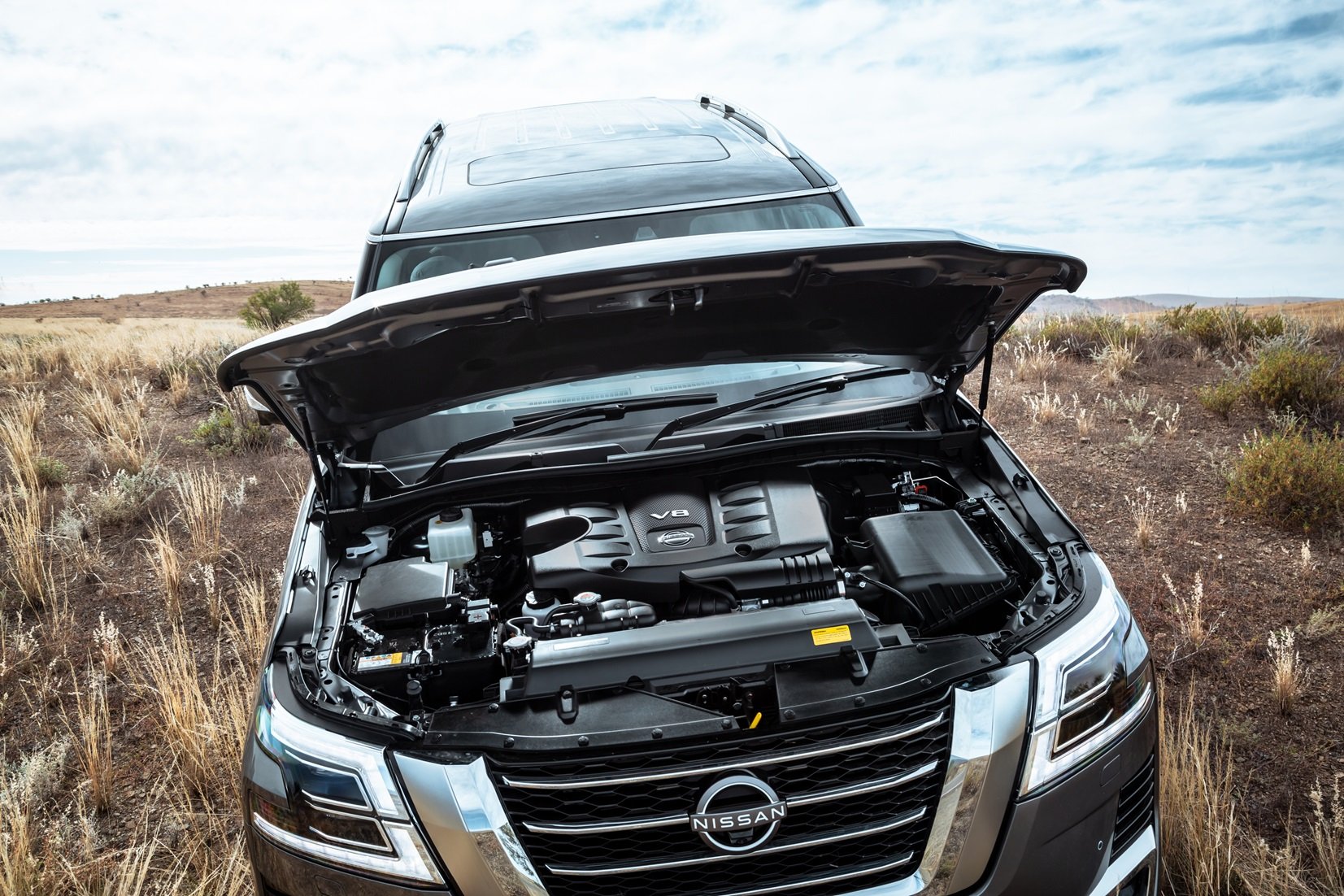
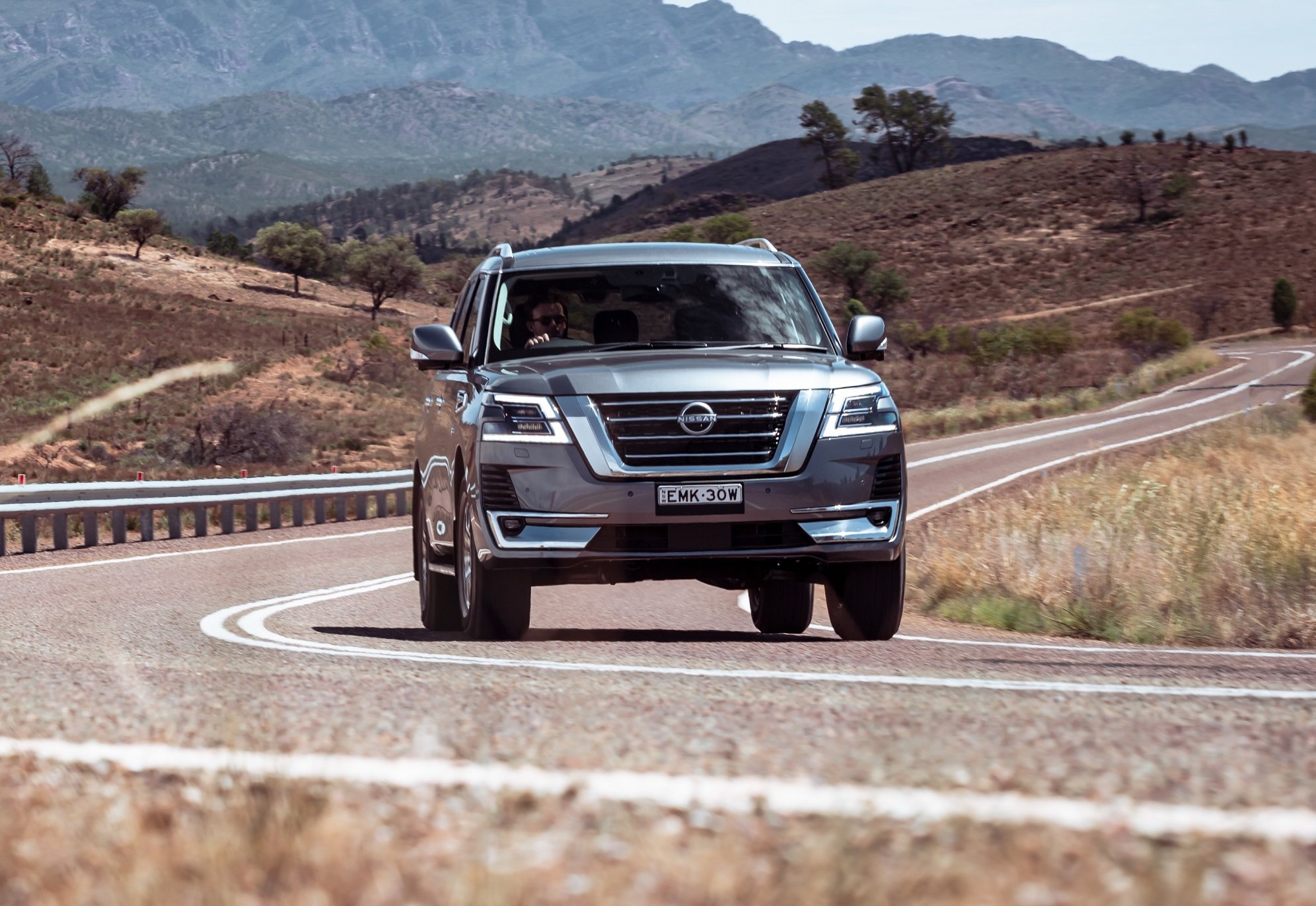
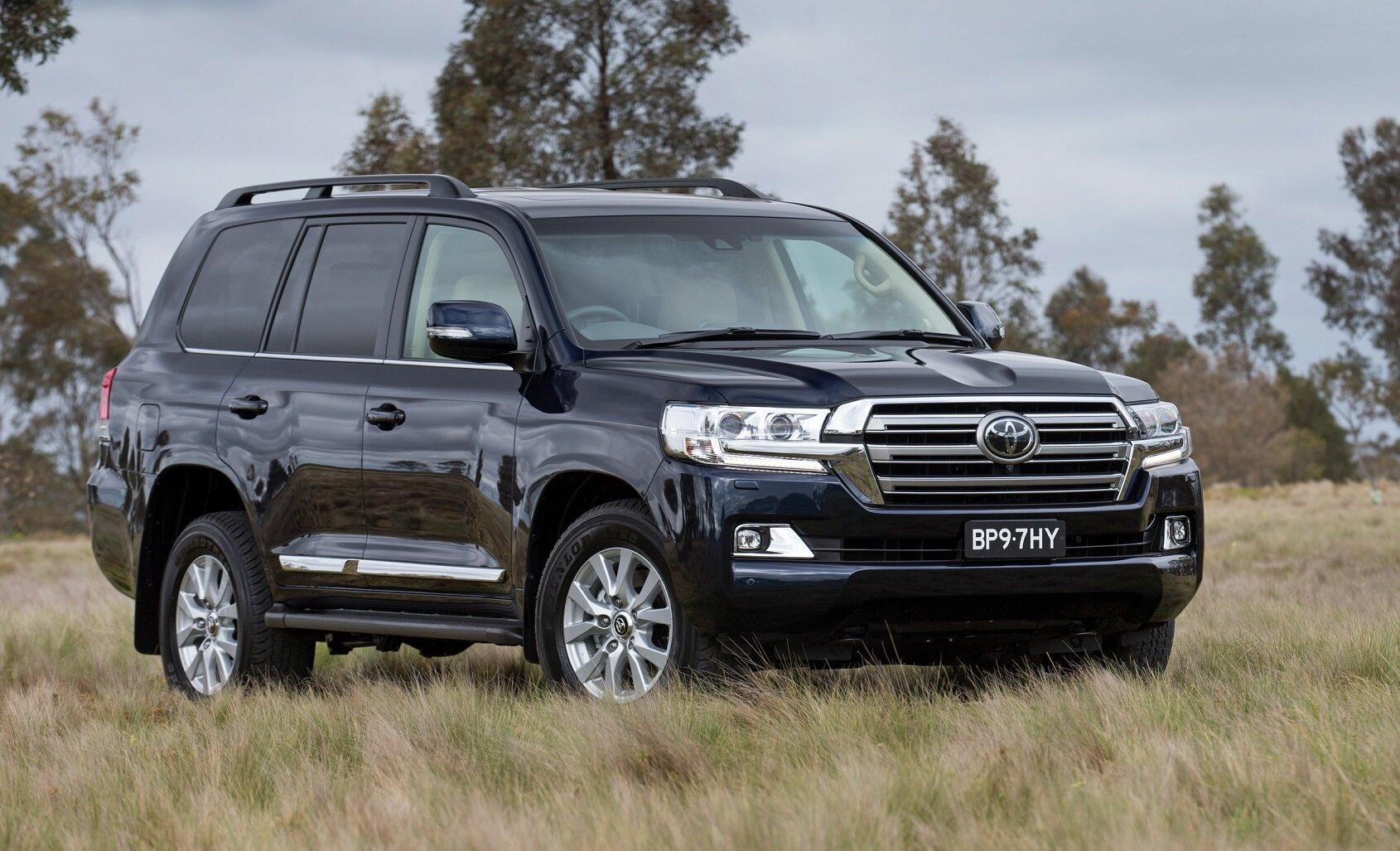
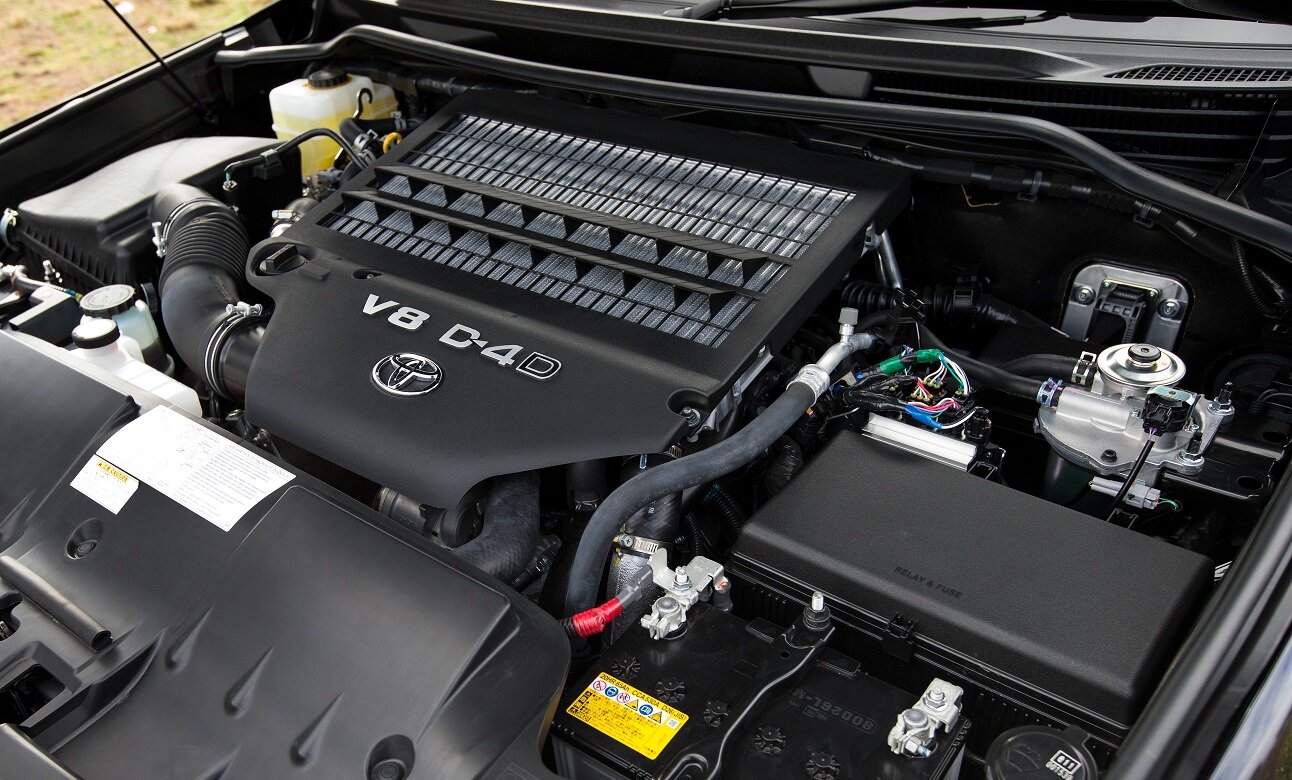
Engineers use this language whenever they talk about BMEPs (break mean effective pressure) and BSFCs (brake specific fuel consumption), so we're going to help you make sense of all of this and use it in a meaningful way.
Let’s look at Marcus Craft's tow test from February 11, 2020. Crafty is a really good 4x4 journo, he works at CarsGuide. I don't often praise motoring journalists but I've got deep respect for Crafty and his work, so I trust his results here.
He did a tow test with a LandCruiser 200 and a Nissan Patrol Ti.
It was V8 diesel versus V8 petrol and they used a control caravan called the Jayco Silver Line, which weighed 2650kg tare weight; a nice conservative towing assignment for vehicles such as those.
What impressed me was the results: Crafty got a consistent and expected 23.5 litres per 100km for the LandCruiser, and 12.6L/100 unladen. This doubled fuel consumption makes perfect sense because with more wheels on the deck roughly double the amount of rolling resistance, caravan's substantially larger, so roughly double the amount of aerodynamic drag and roughly double the weight. The LandCruiser weighs in at about 2.7 tonnes, so roughly double everything and they got roughly double the fuel consumption.
It probably was a little bit less than double because you can't go quite as fast when you're towing a big heavy caravan and not be conservative.
Crafty drove a 140 kilometre loop on the highway and some good dirt roads, some unsealed roads and some B-roads as well.
To make sense of this test, we're going to have to make a couple of assumptions, but we're using the data to make BSFC work for us.
Essentially, we need to work out how many kilowatts it takes to do this towing job.
Fuel consumption is 23.5 (from Marcus's test), diesel is about 850 grams or 0.85 of a kilo for every litre, and let’s estimate Crafty managed 75km/h average speed for his test.
For every hour that he drives, the vehicle is going to use three quarters of the 23.5 amount of fuel, which is 17.6 litres of fuel, which weighs about 15 kilograms, so we've got 15 kilos of fuel to burn in an hour.
So how many kilowatts come out the crankshaft?
Easy: 15 divided by 0.2 equals 75 kilowatts.
The LandCruiser peaks at 200 so we're well under half of the peak power output.
Even down lower in the rev range we know that the LandCruiser makes peak torque of 650Nm between 1600-2600 RPM. There's a relationship between torque and power: power is strictly mathematically joined to torque, which is, kilowatts are the newton meters multiplied by RPM, divided by 9549. This comes from first principles, but you have to convert RPM into radians per second, and that's difficult, mathematically.
Or you can just plug it into this formula.
So, 650Nm at 1600 RPM is 109 kilowatts. At 2600 it's 177 kilowatts and it just goes up on a straight line between 109kW and 177kW at 1600 RPM, and 2600 RPM. Then, when you get up to 3600 RPM, it's 200kW.
Even at 1600 RPM there's still enough power available with a heavy throttle application, but we're not even using three quarters of the power that's hypothetically available at 1600 revs to do this average driving at 75lm/h. In practice, a vehicle’s transmission is really just an exchange system, exchanging torque and revs.
You can have more torque or you can have more revs, but you can't have both. At high speed, you've got lots of revs driving the wheels, but you don't have as much torque available or being used.
This exchange mechanism, in practice, means that at 1600 RPM going downhill with your caravan, you might be doing say 75-80km/h and you reach 90-95km/h on the way down - but then you get to the flat section before and you start going uphill, where you increase throttle, and transmission during this sequence has been responding to the amount of power and torque required by changing gears. It changes gears to exchange the right amount of torque for power needed to meet the demands of the throttle (you, the driver).
Going downhill, the transmission shifted up, doing quite low revs and then as the accelerator demand from the driver increases, the transmission delivers more torque by changing to lower gears to give more revs and therefore you've got more power available, hypothetically.
Essentially, you don't have to go flat-out with high revs because when you change back a couple of gears and go from 1600 to 2600 RPM for any throttle position, you're roughly 70 percent increase in power thanks to the revs increasing.
It really doesn't take that much power to drive a caravan anywhere, it's a small amount of power. This is why the power output of the engine is rarely the limiting factor when it comes to a particular vehicle's towing capability.
Unfortunately, we're never going to be able to drill down into the weakest link of every vehicle because manufacturers won't tell us enough information, but I'll guarantee with just about every vehicle capable of heavy towing, it's not power output that is holding you back.
COIL OR LEAF SPRINGS?
When it comes to towing in relation to dual-cab utes, leaf springs are generally better for towing because they deal with the heavier loads at the rear, offering better (reduced) cantilever effects all the way out the back.
You might think one type of suspension, like leaf springs, is strictly better for towing than coil springs. In the case of the Nissan Navara, that has certainly been the case, generally speaking, during that vehicle’s lifetime. And for utes, yes, leaf springs are best.
But you would hardly suggest a Patrol or LandCruiser is worse for towing because of their coil springs, than say a Hilux or Triton with leaf springs.
What matters is how those suspension components function, like the leaves or coils, the dampers working within them, the bushes, and the various components around them.
UPGRADING GVM for TOWING
Imagine being Toyota, with all those truly impressive R&D resources, designing a vehicle to handle rugged terrain, heavy towing and big loads. Imagine knowing all that you know about the underlying structure and the performance of your design. imagine having access to all the FEA files, and all the data from thousands upon thousands of laboratory and real-world testing sessions.
Imagine having then to impose structural load limits on the platform, in the interests of safety and longevity (of the structure and the powertrain). This is important because you’re selling Landcruiser into a competitive marketplace, and any limitation you place on the vehicle, if unduly conservative, will give competitors an edge. You definitely don’t want that.
Against this backdrop, imagine some clown (or in the case of Australia) clowns, in the aftermarket industry, thinking they know better than you. Imagine them thinking all it takes is fitting a set of different springs and shocks. Why didn’t you think of that?
Answer: Because it’s not a good idea.
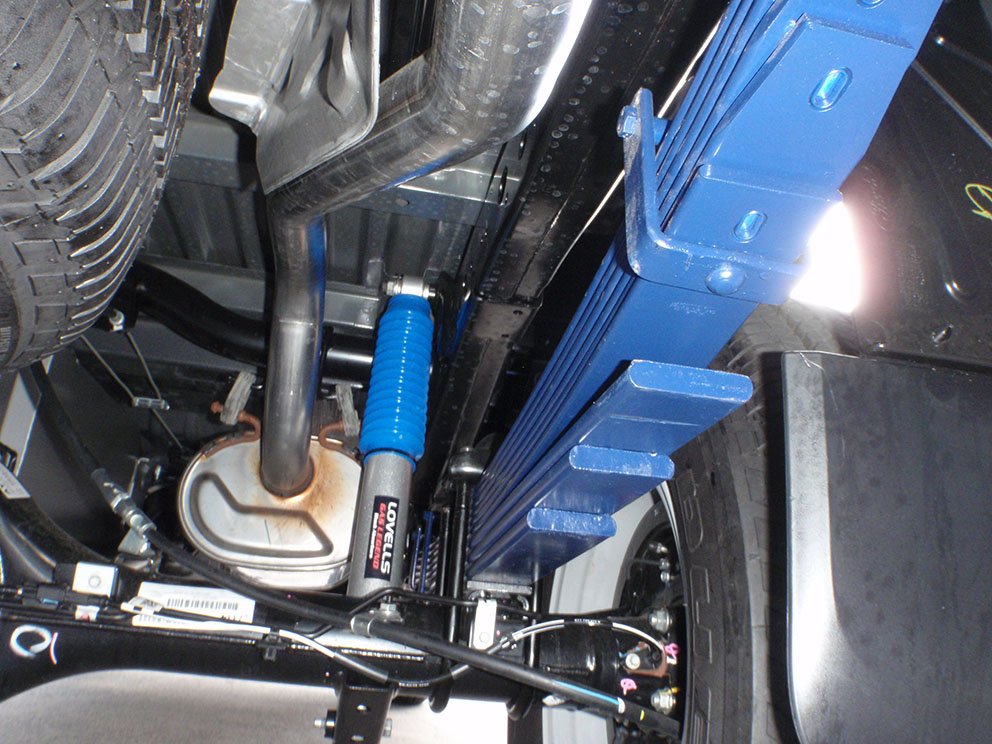
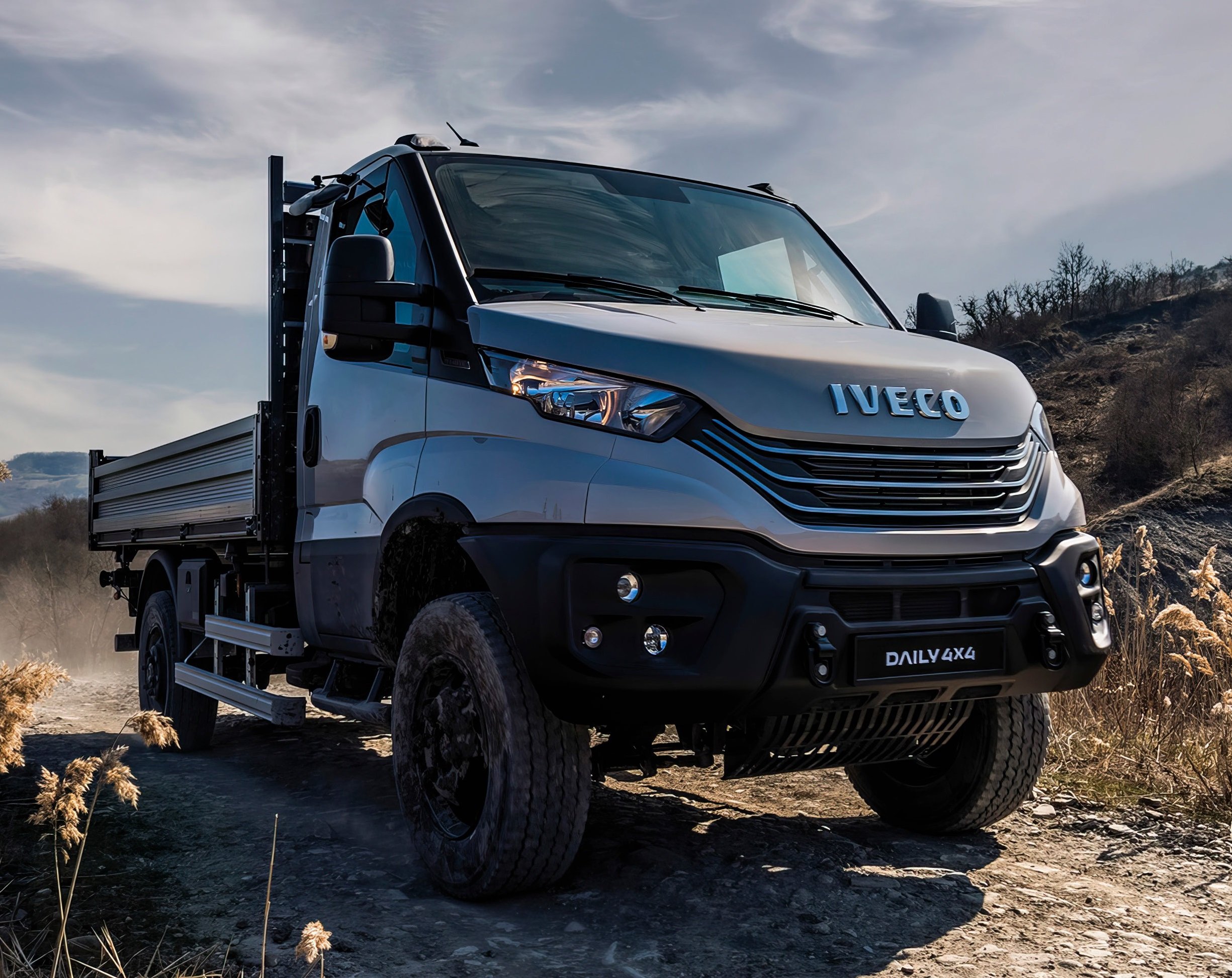
At the end of the day, with an aftermarket GVM upgrade, the same structure and the same powertrain are going to endure more load than the manufacturer intended. In my view that’s a very poor idea. There are actual loads being imposed on actual things here. This is not solely an administrative compliance issue. It’s a safety and reliability issue.
Imagine Boeing defining the load limitations of the 787 Dreamliner, and Qantas trotting off to ARB for a quick GVM upgrade. Do you want to fly in that aircraft? (I certainly don’t.)
Pedders offers a +500kg payload GVM upgrade for Landcruiser 200 - springs, dampers and brakes. Same chassis. Same powertrain.
A standard Landcruiser 200 GXL has a payload capacity of 610kg. We’re talking about increasing this by an incredible 82 per cent. If there really were this much latent capacity to carry load built into the 200 Series, do you not think Toyota would just fit those different springs, dampers and brake pads? (Or ones just like them?) Perhaps there’s a really good reason why they do not…
This kit increases the GVM of the vehicle from 3350kg (standard) to 3850kg. It’s 15 per cent more mass - being amplified by being accelerated over rough terrain, imposing substantially greater loads on the platform and powertrain…
On the administrative front I’d want to see some evidence of ongoing warranty compliance from Toyota (in writing) - not the dealer - before you do this. Because - face facts - if the powertrain fails or the platform fails, and you go back to Toyota, they are likely to say that you are operating the vehicle outside its intended design range and they are under no obligation to warrant your problem in the circumstances. In other words, they’ll likely say you overloaded the vehicle and it’s not their problem.
The GVM upgrade provider will likely claim a Toyota manufacturing defect caused the problem, and therefore it’s not their problem.
In this situation - blown transmission, blown turbo, melted piston(s), etc, looking down the barrel of a five-figure repair bill - you’re stuck in the middle, between two parties who can allege, with some legitimacy, that it’s really not their problem. Your only option is lawyers and professional experts and high fees (parties to matters in consumer courts typically wear their own legal costs).
Does this sound like fun? Because I’ve had fun, and frankly, this ain’t it. In my view, it’s potentially dangerous, it has serious longevity-threatening implications, potentially, and it’s a huge potential can of worms if something goes wrong.
Plus I would want to understand the insurance implications - do not do this under the radar in respect of your insurer. Make sure they know about your GVM upgrade and it’s noted on the policy - because you don’t want to crash and them to attempt to weasel out of it because you didn’t tell them you had modified the vehicle in such a serious way.
If you need to carry heavy loads, buy a 4WD truck (not a ute, a truck).
I know this is not what you want to hear. Facts can be like that (so inconvenient).
.
BAD TOWING: CONSEQUENCES & CONCLUSIONS
What happens when you don’t actually get caught by the roadside whilst towing an overloaded trailer, and overloaded vehicle and/or driving in a dangerous manner?
If you get it wrong, and someone is injured or killed, or you destroy other people’s property due to your negligence, here’s what happens afterwards:
Alternatively, you may never get caught by authorities at the roadside, but you could very easily wind up getting caught on dashcam video by other ambient road users whom you endanger along the way.
And when/if things do go horribly wrong, and the police show up, and then your insurance company finds out you were overloaded, well, they’re always looking for a way to deny paying you out.
Here’s what that looks like in practice:
QUESTIONS & ANSWERS
Just in case you still have any lingering questions about some of the more technical aspects of how towing disasters happen, here are some answers to queries made to AutoExpert after that towing disaster incident…
SAVING YOURSELF FROM TOWING DISASTER
This is important. It’s applicable to all loss of control and skidding, sliding events - not just towing tank-slappers. If you notice the trailer starting to sway:
There’s a phase of these incidents where the event is potentially recoverable, and disaster may be averted if you get this right. So, in this phase, accelerate gently, to keep the coupling in tension, keep your vision up and orient where you want to go, with both hands on the wheel. Then hope for the best - better if you’re at a moderate speed.
But if you transition to phase two, and you are crashing because there’s nothing left you can do, or you’re inevitably about to crash, then BRAKE. Brake heavily. Attempt to snap the brake pedal off and push it through the floor. If you are going to crash, the best possible outcome generally happens at the lowest possible speed. (Balance of probability.)
The Swiss Cheese Theory
When you’re towing, there is a pathway for disaster, with lots of varying factors in place. If the holes all line up, that’s when a towing disaster will happen.
If you:
Overload your vehicle, and;
Overload the trailer, and;
Drive too aggressively, and;
Your tyre pressures are down slightly, and;
It’s a rainy day following a spate of hot weather, meaning;
There’s excessive oil on the road from the bitumen, and;
You’re tired from the big Friday night knock-off drinks, and;
You lazily packed your ute’s cargo, and;
You hit a pothole which unsettles the rear end and the caravan, and;
You’ve got only one hand on the steering wheel, and;
You took too long to accelerate as the trailer starts to sway, and;
You instead stab the brakes
This is the series of events lining up that cause a towing disaster that ruins not just your holiday, but everybody else’s.
The people effected by this are all around you, including the police, firefighters and paramedics who all have to rush to save your life, and resuce your family, and cut out anybody else who you crash into. It involves the truck drivers who cannot slow their trucks down fast enough, the innocent bystanders and other road users who are all partially distracted and traumatised by the near-miss.
Professor James Reason said that if you just change one of these Swiss cheese factors, you prevent a disaster.
Instead, if you make the choice to:
reduce the mass of your trailer, or
choose to have an early night before the big towing pilgrimage, or
reducing your speed in the wet, or
delay your set-off date by one night so you can drive on a less-busy day, or
simply put both hands on the wheel and drop back from the vehicle in front so that you see the pothole sooner and avoid it entirely
…this potentially deadly event never happens, and you get there in one piece.
Towing is a serious mission and you should treat it with the respect such an undertaking deserves.






